#tierney grain
Explore tagged Tumblr posts
Text

8 notes
·
View notes
Text
Février MMXXIV
Films
Maigret voit rouge (1963) de Gilles Grangier avec Jean Gabin, Michel Constantin, Vittorio Sanipoli, Paul Frankeur, Guy Decomble, Françoise Fabian, Paulette Dubost, Laurence Badie, Roland Armontel et Jacques Dynam
L’Étau (Topaz) (1969) d'Alfred Hitchcock avec Frederick Stafford, Dany Robin, Claude Jade, Michel Subor, Karin Dor, John Vernon, Michel Piccoli, Philippe Noiret et John Forsythe
Flic Story (1975) de Jacques Deray avec Alain Delon, Jean-Louis Trintignant, Renato Salvatori, Claudine Auger, Maurice Biraud, André Pousse, Mario David et Paul Crauchet
Poupoupidou (2011) de Gérald Hustache-Mathieu avec Jean-Paul Rouve, Sophie Quinton, Guillaume Gouix, Olivier Rabourdin, Joséphine de Meaux, Arsinée Khanjian, Clara Ponsot et Éric Ruf
Air Force One (1997) de Wolfgang Petersen avec Harrison Ford, Gary Oldman, Glenn Close, Wendy Crewson, Liesel Matthews, Paul Guilfoyle, William H. Macy et Dean Stockwell
Bob Marley: One Love (2024) de Reinaldo Marcus Green avec Kingsley Ben-Adir, Lashana Lynch, James Norton, Henry Douthwaite, Sevana, Hector Lewis et Tosin Cole
Sister Act (1992) d'Emile Ardolino avec Whoopi Goldberg, Maggie Smith, Kathy Najimy, Wendy Makkena, Mary Wickes, Harvey Keitel, Bill Nunn et Robert Miranda
Astérix : Le Domaine des dieux (2014) d'Alexandre Astier et Louis Clichy avec Roger Carel, Lorànt Deutsch, Guillaume Briat, Alexandre Astier, Alain Chabat, Élie Semoun, Géraldine Nakache, Artus de Penguern, Lionnel Astier et François Morel
Race for Glory: Audi vs. Lancia (2024) de Stefano Mordini avec Riccardo Scamarcio, Daniel Brühl, Volker Bruch, Katie Clarkson-Hill, Esther Garrel, Gianmaria Martini : Hannu Mikkola et Haley Bennett
Buster (1988) de David Green avec Phil Collins, Julie Walters, Larry Lamb, Stephanie Lawrence, Ellie Beaven, Michael Attwell, Ralph Brown et Anthony Quayle
Laura (1944) d'Otto Preminger avec Gene Tierney, Dana Andrews, Clifton Webb, Vincent Price, Judith Anderson, Dorothy Adams et Lane Chandler
Séries
Affaires sensibles
Présidentielle de 1995 : un scandale d'Etat - Michèle Mouton, le Groupe B et les Finlandais volants - Les Ecoutes de la République - La secte du temple solaire, le drame d’une société secrète - Munich 1972 : destin tragique d'un rêve olympique - Les révoltés des Jeux olympiques - Le crash de la Germanwings - Alexandre Litvinenko, victime d’un permis de tuer - Martin Luther King : la naissance d’une icône - Martin Luther King : du rêve au cauchemar - Dans l'ombre de Gérard Lebovici - Macron 2017, le traitre méthodique - Kurt Cobain, portrait d’une génération - Crash au mont Saint Odile
Maguy Saison 1
Rose et Marguerite, c'est le bouquet - Babar et Bécassine se mènent en bateau - Docteur j'abuse - L'union fait le divorce - L'annonce faite à Maguy - Le coupe-Georges - Amoral, morale et demie - Cinquante bougies, ça vous éteint ! - A visage redécouvert'' - Le serment d'hypocrite - Tu me trompes ou je me trompe ? - Comment boire sans déboires - Un veuf brouillé - Le père Noël dans ses petits souliers - L'emprunt ruse - Tous les couples sont permis - L'amant de la famille - Travail, famille, pas triste - Blague de fiançailles - Macho, boulot, dodo - Mi-flic, mi-raisin - Trop polyvalent pour être honnête - La traîtresse de maison - Les trois font la paire - Un grain peut en cacher un autre - La quittance déloyale - Belle-mère, tel fils - Manège à quatre - Comme un neveu sur la soupe - Toutou, mais pas ça ! - A corde et à cri - Jamais deux sans quatre - L'amant comme il respire - Le chômage, ça vous travaille ? - La faillite nous voilà ! - Le divin divan - Toubib or not toubib - L'écolo est fini - Loto, route du bonheur
La croisière s'amuse Saison 2
Un contrat en or - Le Magicien - Copie confuse - Un travail d'équipe - Accrochez-vous au bastingage - Le Célèbre Triangle - Joyeux Anniversaire : première partie - Il y a si longtemps déjà - Passion - Un coup de roulis - Docteur, vous êtes fou - La Petite Illusion - Donne moi ma chance - Qui vivra verra - Réunion de travail : deuxième partie - Méfiez vous de votre meilleure amie - Vague à l'âme - L'amour est aveugle - Chassé croisé
Downton Abbey Saison 6
À l'aube d'un nouveau monde - Le Piège des émotions - En pleine effervescence - Une histoire moderne - Plus de peur que de mal - En toute franchise - Aller de l'avant - Les Sœurs ennemies - Le Plus Beau des cadeaux
Kaamelott Livre IV
Le Jeu de la guerre - Le Rêve d’Ygerne - Les Chaperons - L’Habitué - Le Camp romain - L’Usurpateur - Loth et le Graal - Le Paladin - Perceval fait ritournelle - La Dame et le Lac - Beaucoup de bruit pour rien - L’Ultimatum - Le Oud II - La Répétition - Le Discours - Le Choix de Gauvain - Fluctuat nec mergitur - Le Face-à-face : première partie - Le Face-à-face : deuxième partie - L’Entente cordiale - L’Approbation - Alone in the Dark II - La Blessure d’Yvain - Corpore sano II - L’Enchanteur - Les Bien Nommés - La Prisonnière - Les Paris III - Les Plaques de dissimulation - Le Vice de forme - Le Renoncement première partie - Le Renoncement deuxième partie - L’Inspiration - Les Endettés - Double Dragon - Le Sauvetage - Le Désordre et la Nuit
Coffre à Catch
#153 : Finlay, le retour ! - #154 : Gloire aux Heels ! - #155 : Les débuts historiques de Sheamus ! - #156 : Les Bella Twins arrivent à la ECW ! - #18 ; CM Punk continue d'impressionner & quelqu'un fait du vélo ! - #12 : Le Push de CM Punk + Bsahtek le Bikini !
Castle Saison 4
Sexpionnage - Jeux de pouvoir - Une vie de chien - Le Papillon Blue - Pandore, première partie - Pandore, deuxième partie - Il était une fois un crime - Danse avec la mort - 47 secondes - Au service de sa majesté - Chasseurs de têtes - Mort vivant - Jusqu'à la mort s'il le faut
Les Brigades du Tigre Saison 1
Ce siècle avait sept ans… - Nez de chien - Les Vautours - Visite incognito - La Confrérie des loups - La Main noire
Alfred Hitchcock présente Saison 2, 6
Incident de parcours - Pièce de musée - Reconnaissance
The Grand Tour Saison 5
Trop de sable
La ville Noire
Première partie - Deuxième partie
Les Petits Meurtres d'Agatha Christie Saison 3
Mortel Karma
Spectacles
Monsieur chasse (1978) de Alain Feydeau avec Michel Roux, William Sabatier, Françoise Fleury, Yvonne Gaudeau, Pierre Mirat, Xavier Vanderberghe, Michel Mayou, Bernard Durand et Roland Oberlin
La Bagatelle (1977) de Jean Meyer avec Amarande, Patrick Préjean, Jacques Balutin, Brigitte Chamarande Bel, René Lefevre, Pierre Aufrey et Didier Roussel
Femmes en colère (2023) de Stéphane Hillel avec Lisa Martino, Gilles Kneusé, Hugo Lebreton, Nathalie Boutefeu, Fabrice de la Villehervé, Sophie Artur, Clément Koch, Magali Lange, Aude Thirion et Béatrice Michel
La Pélerine écossaise (1972) de Sacha Guitry avec Jean Piat, Geneviève Casile, Philippe Etesse, Robert Manuel, Raymond Baillet, Françoise Petit, Alain Souchères, Janine Roux et Ly Sary
Livres
Piège de chaleur de Richard Castle
Spirou et Fantasio, tome 15 : Z comme Zorglub de André Franquin, Jidéhem et Greg
Kaamelott, tome 1 : L'Armée du Nécromant d'Alexandre Astier, Benoît Bekaert et Steven Dupré
OSS 117 : Tactique Arctique de Jean Bruce
Astérix, tome 17 : Le Domaine des dieux de René Goscinny et Albert Uderzo
4 notes
·
View notes
Text
Tierney, and Where the Story Began
Recently did a series of polls to decide on my Baldur's Gate 3 Early access character. What we landed on was this:
Tiefling, Trickery Cleric (Tymora), with an Entertainer background.
This is them, as decided by popular vote:
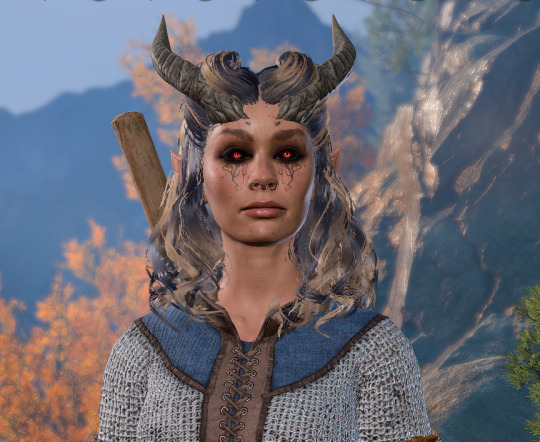
And this is their story, as I have decided. Some of the details might not apply so well once I get into the game, but I have had so much fun coming up with this story all the same. I am already very attached.
(TW: Depression, abandonment, grief)
~ I was born Tierney, in a small hamlet southeast of Loudwater to a solitary trapper who spent more time in the foothills of the Greypeak Mountains than amongst other folk. I grew up understanding the quiet solitude of the vast world around me, and the few times we ventured into towns to sell leather and furs and meat I always found to be bizarre and almost fantastical. The rhythm and closeness of it all seemed almost supernatural to me.
For the most part though, my mother and I kept to ourselves. She raised me alone, but I never felt the absence of other people. The land was too full of life for that, and mother was too good at telling stories for me to grow bored or dwell upon loneliness. Some of the things she would tell me she’d declare were history, sometimes heart breaking and cruel, sometimes powerful and undeniable.
“The bones of our world,” she call them.
Other times the tales she wove were strange and silly, impossible things full of wonder and humour. I would laugh and laugh and insist that I did not believe a word of it and that she could not fool me.
“Why, my little rabbit’s foot,” she would say, winking at me over the fire, or as she set traps, “anything is possible. Don’t you know the world is vast?”
That was before she got sick.
I’d thought I had know solitude before, that it was a comforting friend. Without her I realized what it was to truly be alone. I tried to be like her, I did. I tried to be content under the open sky and among the trees. I looked for serenity in the dirt under my feet, and the nip of the wind across my face. I told myself stories by the fire and as I set traps, sang songs she used to sing. But with no one to rely on except for my own self, the world began to feel a little too big and a little too indifferent and cold.
The twilight caw of the carrion birds began to contort into eery and eldritch scream. The barking of foxes and coyotes began to sound a little mocking and hungry. It was odd to find the shadows of the forest haunting, twisted and dark when once they had been cool and welcoming shade.
And then came my thirteenth winter, not even a year after my mother’s passing. It was a cruel and terrible long freeze. Prey grew ever more scarce, and what I did manage to catch in my traps often got scavenged by other creatures and I found myself more and more often trying to fend off the starving forest creatures, patrolling my trap line in the bitter cold, exhausted and with a constant cough and sniffle.
And then, when spring should have already been easing back the thick snowfall, but was continuing to hide its face, the large cats began to come down from the mountains, ravening with hunger.
I remember going out to check my traps, mind foggy with a fever I couldn’t shake, and stomach hollow with hunger that my dwindling stores of grain could not sate. I remember the blood, the torn carcass, and the low, yowling growl that drifted somewhere between warning and hunger.
I remember thinking that my luck surely had run out that day.
The rest is a blur of snow and fear and branches clawing at my face. The cold burned in my throat and lungs, and my ribs ached with the beat of my heart.
There is no outrunning wild beasts. Especially not as a sickly child, half starved and near delirious from fever. It didn’t matter how well I knew the woods, not with the snow hungrily devouring my awkward, gangly stride. I wasn’t so foolish as to think that climbing a tree would help keep me away from a mountain cat, that I could out last its patience in the cold.
But I ran all the same, and I prayed to whoever might have been listening.
I’m sure it was the luck of the devil that sent my tumbling head over heels down the steep embankment that overlooked a cold mountain creek, frozen over for months. It left me with cracked ribs, a dislocated hip, and a concussion that did nothing for the fever. I was told later that I bounced off of no less than three rocks and four trees, and rolled off a drop of at least eight feet, and I was lucky the snow that had built up over the frozen stream cushioned my fall somewhat. And most of all, I was lucky for Crusoe.
He never would tell me what he was doing out in those woods, all on his own. He’d just wink and tell me how very fortunate I was that he had been. He’d tell me that I was lucky he had been born with a knack for little tricks and magic, and that the mountain cat was too clever to risk a fight with a person who could apparently hurl fire at it. Wild animals are like that. They won’t risk the damage of a fight for a morsel of prey when they’ll have better, surer chances elsewhere.
And then he carried me, a strange and unconscious child who’d all but fallen from the sky back to the nearest town to be healed. It wasn’t an easy process. It took more than a couple weeks to clear the fluid off my lungs, and to keep the fever from coming back. Never mind that I was malnourished and had bones that needed mending. Out in some small hamlet that was still locked in by the long winter there was no magic healing for me. I had to do it the hard, long way. To this day my hip aches in the cold.
As for Crusoe, I don’t know why he stuck around, not really. He was as much a stranger as I was to the little hamlet, supposedly a traveler by trade. He could have left me there, a problem for the townsfolk to solve. Maybe he pitied me, maybe he took one look at the horns crowning my skull, and the dull embers of my eyes, and knew I would not have an easy time fitting in. Maybe it was some noble sense of responsibility that made him want to see me well and looked after with his own eyes. Maybe it was something else, some other thing he wanted to cling on to.
He never spoke of his family in all the years that I knew him after all, and there were times I saw a weariness in his face that made my chest hurt. For all the connections he made, for all the people he spoke to, I wasn’t even sure if he had much in the way of friends. He was always happy to listen, to share a drink and a laugh, but with the exception of the months it took me to heal he never stayed bound to one place for very long.
When the spring finally came, we left together. We’d not discussed it. I just woke up one morning to find that he had packed our things and was told that we could eat on the road. He had seemed to be in a rush, but when I asked about it, he told me that he’d gotten an itch in his feet and if he stayed any longer he thought he would go mad.
Over the course of the next six years we travelled up and down the Sword Coast, drifting from one place to the next. I learned a lot from Crusoe in that time. He was a thespian by nature, and used his talents for storytelling to make his living. He was impressed by my own repertoire of tales, and taught me to expand on that. I learned to change my tone, how to pace my words and adjust the tempo of my speech. I learned to act, to give life to my characters. I learned to breathe from deep in my chest, to project my voice far and wide—something we found my devilish heritage gave me quite the advantage at. I learned how to shift my expressions on a coin. I learned to improvise, and I learned how to listen and remember.
Most of all, I learned to never forget that all the world was stage (that seemed to mean different things to Crusoe, at different times, and I’m not sure I’ve uncovered them all yet).
But then, just as I was about to turn twenty, something changed. I couldn’t quite put my thumb on what gave it away, the moment I truly noticed, but one day it was as if suddenly Crusoe’s stage was a little different than mine. As if he was reading from a script that I did not know, and looking out at an audience I could not see.
Perhaps I’m simply imagining things in retrospect, trying to find some through line, some explanation for the change, but I look back on those times and I wonder if maybe his smile was a little strained, if I caught him staring blankly into the distance, some half formed and frozen expression on his face that I couldn’t understand. When I woke up in the night, on the side of the road, why had he still been awake staring up at the stars, or maybe into the deep darkness between them, so very still that I’d wonder if he’d turned to stone.
I may never know, because I woke up one morning, in a backwater town with an inn that had little more than three rooms to rent, to find Crusoe and all his things gone.
For a while I thought that he might come back so I stuck around, doubtful and confused. After several weeks of telling stories for meagre coin that grew more meagre by the day, I decided that maybe if I hit the road I would cross paths with him. Maybe I’d find him standing in a town square, his eyes alight with mischief and merriment, a hoard of small children gathered around him with faces contorted in awe. Maybe I would find him sitting on a stump by the side of the road, the end of his pen caught between his teeth and ink on his fingertips. He would look up in surprise, flush with embarrassment for being caught. We’d fight. He’d make excuses, and I would sulk and stew in bitterness. Things wouldn’t quite be the same, but we would make it work and maybe I would finally learn about some of his stories. The ones he never told.
Four months later I found him in a small seaside town, emaciated and stuck in a coma in a small church that was little more than a shack with a shrine and a loft. He was being tended to by the young priest and herbalist who tended to the church, and she told me that he had washed up on the shore one morning, covered in strange injuries. The fishermen had brought him to her for healing, but she had not been able to do anything for him, because he was cursed and it was far beyond her abilities to undo whatever fell magic had bound itself to him.
I stayed for a time, fearing he would simply slip away the minute I wasn’t looking. Lorelei, the priest, said that his condition was very unstable, and that he was clinging onto life by only a thread. All I could think of was that look in his eyes as he stared into the space between the stars, and whether maybe that hadn’t been the case for a very long time.
I tried to find answers for where he had been, and what had made him this way, but all of his things were gone, lost to the sea no doubt. The only thing that was left was a a strange metal amulet that Lorelei warned me not to remove, as trying had stopped his heart and forced her to resuscitate him—something she wasn’t sure would work a second time. Other than that, he had a two faced coin in his pocket, which both Lorelei and I determined was utterly mundane as far as our limited abilities could discern.
I sat by his sick bed (I tried so hard not to think of it as his death bed, but it grew harder as time passed and he wasted away more and more), flipping that two faced coin over and over in my fingers, and I talked. I told stories we had told together a hundred times or more. I asked questions that I had always been to afraid to ask. I whispered accusations, and I begged, and I bargained, and I almost gave up hope.
I think I almost would have gone mad sitting there in that chair, if not for Lorelei, who dragged me outside one day to help her with her rounds in the town delivering medicines and checking in on the people.
Maybe it was because it was all I knew how to do, but on one such venture I found myself telling a story to a child who sat by the fountain and stared with sad little eyes at the other kids and fiddled with the pinned up legs of his empty trousers. And then I told another one, and another, and at some point I might have cried.
It was nightfall when I stopped, the parents coming out and urging the crowd of tiny faces that had collected around me to return home breaking me out of my daze. Across the way, Lorelei looked on. She came and sat next to me and we spoke for a time, late into the night, far away from Crusoe’s sick bed with the stars shining down on us both. We spoke of many things, and many of them were very embarrassing for me, fears that had snaked along my thoughts since my mother had left me, but had bared their fangs since Crusoe had left.
And so Lorelei told me about faith, and she talked to me about chance, and she talked to me about fate. And then she slipped the coin from my fingers with a tiny little grin, and tossed it into the fountain and told me that at the end of the day, it was all a gamble. It was just up to us to rig the odds.
I can’t say when my path found me. It simply happened gradually over the the following years, as I helped Lorelei with her duties during the day, and local legends and all many of accounts regarding vile magics during the day, hunting for a solution. It happened gradually, with every coin I’d toss into the fountain, and every late night by Crusoe’s sick bed pouring over books and texts I’d uncover from the church’s lacklustre library, or buy from travelling merchants. It happened on my short forays to nearby towns as I chased rumours and hunted for scholars and arcane practitioners. It happened with every bruised knee and rattling cough I watched Lorelei tend to.
It happened with ever fragile bit of faith I cultivated in myself.
It happened with every time I held on to Crusoe’s hand and thought of all the things I would say when I got him to wake up.
It’s been more than six months since I have seen him last. I found a lead, and I will chase it down, come hell or high water. Lorelei will keep him alive until I return, and when I do, I’ll wake him up, and we will tell each other our stories.~
#writing#creative writing#character background#baldur's gate#baldur’s gate 3#game character#bg3#bg3 mc#dnd character#cleric#tielfling
6 notes
·
View notes
Text
walshparker:
—
doris day was an interesting choice, parker used to likenesses along the lines of ingrid bergman and gene tierney. not that it drew any less of an amused grin from her, the girl entertained that he’d played into the joke at all—even if his turn involved little to no eye-contact.
“not everyone wants to be around people all the time, either,” she countered in response, her free hand rising to tuck some hair behind one ear. if his answer came off like an assumption of her (and, to her, it had), her own acted as a clarification of otherwise. as if to drive the point home, parker brought her flute to her lips and took a sip.
then, in a sudden movement, she shifted her weight and angled herself so that her side leaned against the railing and she was facing them. “not a new year’s eve fan?” was she fishing? perhaps, though with no real goal in mind.

.

a simple statement. easy to understand. and yet ... and yet, how did they end up collecting new england kids like a twisted game of pokemon go? now they were left worrying over a missing girl, or thinking of dax when a ‘loud and bangy song’ comes on, and kepler would sooner count every grain of sand in the sahara than admit there’s more to the list.
“ you don’t? ” they say, an underlying tone of surprise. much like a dying star, kepler assumed parker would choose to burn if it meant she could be seen. but they’ve been wrong before, they could be wrong again. sometimes it was nice.
he turns at the sudden movement, brows drawn together as he just blinks at her for a moment. weird. “ not exactly different to any other day, ” they reply after a beat. why anyone felt the need to make it more exasperating with false hope and loose promises is beyond him. “ let me guess, you are. ”
#parker walsh !#the way ingrid bergman first came to mind but kepler wouldn't give that to her rip#kep
54 notes
·
View notes
Text
Remembering...

I am a very important person. I need to make it through this. I have so much to look forward to. I have a purpose. I have family. I am important to them. I am a very important person...
How long was the lost soul whispering this? It was only a small candle of light that protected Duard in the encroaching shadows that continued attempts to blind him. So close to losing sight forever; when he wasn’t seeing darkness, everything he saw was red and everything he saw he wanted to kill. The buttery taste of blood dripping down the sides of his maw, tongue licking his canines clean-- another deer killed, this time. The feral beast in control of his body merely clawed at the carcass to pieces. He was not hungry, but the desire to hunt and to kill was all that motivated him to continue. No mage, no alpha, no chains no longer binding him. Free to do what he wished. A slave to instincts. Almost invisible in the darkness of the forest, the black worgen vanished into the shadows after there was nothing left of his prey. On all fours, running again, smelling the air for his next target. How long had it been like this? How long could he last? He had to protect that small light of hope for just a little longer. As long as he had something-- anything-- to hold onto, the cinder of hope would still burn. Months... years? Centuries? Time lost it’s meaning. No matter the length, he needed to hold out...
I have so much to look forward to.. I am important to someone.
Strength waning as more time passed. Inevitable. The taste of blood and flesh became too normal. At this point, he was able to tell exactly what he was tracking, how far it was, and even the number of targets just on scent and hearing alone. This was normal now. Hunting in the shadows was normal. The darkness was normal. Perhaps this was meant to be. Escaping the shade of the forest, the beast sprinted into an open clearing. A perfect view of his surroundings. He heard himself howling like a mad wolf, celebrating his latest kill. On the inside, he mourning his dying humanity. The moon was going to be the last thing he would remember as a sane man. Oddly comforting. Duard closed his eyes. Was this finally the endless peace?
The warm touch of a soft hand upon his face; a voice was calling for him. A calming rush of tranquility was enough for him to push past the emptiness and open his eyes.
He quickly gasped for breath, sitting up from the grass; a large blanket wrapped around him. There was no growling while he breathed. He looked at his hands-- normal human hands again. Feeling his face, there was a human nose in place of the wet nose of a worgen snout. This all felt real. Human. He looked up at the sky. It was still night, but there was no more darkness. The moon was so bright, the stars accompanying it with their own flickers of light. It was beautiful.
“It’s fine, now,” a small voice remarked from what appeared to be a pile of fur sitting next to him. The hand that woke him up withdrew into the mass and lifted up the antlered skull from her head, revealing a wide grin on her tired face. “Do you remember your name?” The Druidess asked. “Do you... remember anything?”
“I remember,” Duard struggled to speak at first, coughing lightly and then spitting to the side. “I am a very important person.”
(A short ramble I guess on him becoming human again for the first time and maybe a bit of a reason why he acts a bit arrogantly)
#writing#wra rp#wyrmrest accord rp#duard paternoster#proofread free writing#his last grasp on humanity was being important to someone#tierney of the grain
4 notes
·
View notes
Text
Tagged by @senjo thank you! A little late but things go wrong, shit happens, life goes on I guess
Why did you choose your url? It’s actually a quote from the movie “Cluny Brown” directed by Ernst Lubitsch from 1946 about a rather unconventional girl who refuses to understand what her “place” in society is. Basically it just means: do what you want if it makes you happy - who cares if everybody else thinks you’re nuts.
Ninotchka, To Be or Not to Be, Design for Living, The Shop Around the Corner... You can't go wrong with any of his movies especially his Hollywood career. Probably my favorite directors with Wilder, Kurosawa, Capra, Ford, Mankiewicz, Howard Hawks, Keaton...
The full quote courtesy of IMDB : Nobody can tell you where your place is. Where is my place? Where is everybody's place? I'll tell you where it is. Wherever you're happy - that's your place. And happiness is a matter of purely personal adjustment to your environment. You're the sole judge. In Hyde Park, for instance, some people like to feed nuts to the squirrels. But if it makes you happy to feed squirrels to the nuts, who am I to say, "nuts to the squirrels?"
Any side blogs? none. only have a squirrelstothenutstest url on private for theming purposes.
How long have you been on tumblr? Since 2012 but was private and didn’t post anything until 2017. I was only browsing classic movies back then on tumblr (silent, western, screwball, film noir, musicals...)
Do you have a queue tag? No but it’s super rare when I don’t queued/scheduled a post.
Why did you start your blog in the first place? It’s not obvious but my original intent behind this blog was to scan and share some photos (Gene Tierney, Toshiro Mifune, Bogart, Cagney, Crawford, Bergman, Harold Lloyd…) from my collection… but scanner died.
And now it’s just for sharing some cool cuts/moments in animation. Still waiting for Tumblr to implement real native webp, gif is an old format from another time. It’s so superior: a 9mo gif is equivalent to a 3mo webp (and without grain).
Why did you choose your icon? Because In This Corner of the World had me in tears when I saw it in theater. I was crying for half of it (the second half).
Why did you choose your header? in the desktop version of my theme, nothing. On mobile, it’s the JJK ending with Haikyuu’s characters. I’m a sucker for dancing sequences in animation.
What’s your post with the most notes? not sure... maybe this blade runner’s gif (when the size limit was 3mo^^)
How many followers do you have? π
How many people do you follow? 616
Have you ever made a shitpost? probably not
How often do you use Tumblr? everyday but not on my dash anymore, I’m using a rss aggregator (feedly) it’s easier to not miss a post that way and you don’t have to deal with ads on mobile. The internet would be useless without rss for me.
Did you have a fight/argument with a blog once? nope, i got twitter for dunking on right wing people lol
How do you feel about “you need to reblog this post”? I'm the kind of the person who tends to compartmentalize my use of social media... so I mostly ignore it on tumblr.
Do you like tag games? Do you like ask games? yes, there’s some ask game about music I would like to do but I’m too anxious that no one would pitch it back to me^^
Which of your mutuals do you think is tumblr famous? we’re on tumblr, everyone is a misfit right here, being tumblr famous is useless
Do you have a crush on a mutual? come on, we’re adults.
Tagging (it’s up to you, you don’t have to if you want): @spaceghosting @nuzell07 @halfpints @kabochapie @flowerymoments @mysterymellie @1gm @mangacapsaicin @silvadour
11 notes
·
View notes
Text
from The Libertines (my novella)
2016
1.
In the woods, there whispered a secret I felt compelled to follow, just to discern its meaning. It could’ve been a blessing or a curse, and still I was brave enough to leave my repressive household for those screams that normally would frighten someone, but I’ve been reduced to a frozen-hearted Banshee on the floor of a seclusion room more than once. I remember the fog of those moments and feeling more broken than even the most dismantled women could get. Screaming because it was expected of me.
I dropped straight out of high school, a nightmare I never hope to relive. Age eighteen was the last time I saw a psychiatric facility. My family and me live in a Tudor mansion in the city’s most affluent neighborhood. The house consisted of my parents and my sister Sinead, who was always the opposite of me. I was the black sheep.
“Mathilde, no one is screaming in the woods,” she’d tell me when I first heard the shrill, ear-scorching girl’s shriek echo from the trees bordering the park.
I ignored her and ran, knocking a stone statue over, seeking out the source of feminine distress.
“Hello? Are you alright?”
“No matter where you go, I’ll find you,” was the whisper that fervently replied from somewhere in the foliage. As though the angel or apparition (whatever she was) could read my mind. I was thirteen.
I was pale and whey-skinned compared to my sister, who perpetually blushed and took better care with her pretty countenance. She snagged Dale Tierney before I could get to know him; naturally someone like him would gravitate towards an extroverted floozy like my sister, Sinead. He greeted me politely but tersely upon visiting our house, as I was not the subject of his interest. My sister was seventeen, and a senior in high school, while I was in ninth grade, a razor-freak and antisocial, maladjusted misfit. Sinead pretended not to notice. My cuts bled on tiles to industrial rock music. No one could stop me.
*
“Mathilde-”
“Don’t speak, or I’ll excavate your heart from your chest and incinerate it while I smoke a coffin nail,” I replied. He was chasing Dale with a bat, and I remembered a brief feeling just like getting fucked with a knife. Some bat-wielding perverts had jumped me several years ago and shoved the handle in.
“Mathilde!”
“I’ll eat your heart before I burn it over the pyre,” I snapped. There wasn’t really a pyre.
In the abandoned grain elevator building made of cement, a place I pretended was a mental institution, I executed him. Lobotomized, Never anesthetized, because I wanted him to feel like hell. I always knew there was no inferno underground where bad people like myself and this man who is dying beneath a series of rope knots go. I have bound him in a length of chain as well. Years ago, long after the screaming in the foliage to the cacophonous magpies had ceased, I heard a woman or young girl wail in agony above the ceiling. The attic I never went up in because it was asbestos-ridden, and I wondered how schizophrenic I had become.
I told my father (a man who once told me “try harder” while I pretended to asphyxiate myself with a shoelace adorning the knob of my bedroom door) that I heard a scream erupt from the attic.
“Well, your intake with mental health is tomorrow,” my dad replied. “We’ll get you on the right meds.”
I hoped and prayed there was no reality behind the scream.
The house was over 100 years old; it could’ve been a benevolent or malevolent apparition.
He’s dead. The assailant from the grain elevator.
I splashed him with acid and dissolved him into the floor.
I see Dale watching me from a doorway.
“I am Hell itself,” I tell him. He seems to know the guy I offed was scum.
We laugh.
*
I wake up from my zoning out on the couch at 3 a.m., content, knowing I had no part in it. None of it was my fault. Tori Amos’s To Venus and Back album has played on repeat all night. I could’ve retained my innocence if the city’s pathetic excuse for a population cut me a little slack, but now all I have time for is complete, indisputable indifference. And euphoria over everything, hedonistic amusement showing at all times. So happy I could die in outer space. I wouldn’t even care. I used to put methamphetamine mixed with angel dust (PCP) into my bloodstream and it was then that I discovered a drug that could take away the fear of death itself. A man said, “Get the fuck out of here or face my gun.” I saw no gun to speak of and felt numb with nothing but mania in my head under the freight train bridge. I moved myself as far away from him as I could go. I was full of amphetamines under the bridge. A place downtown full of drama and drugs. I saw a man hold a knife to the throat of a man in his late teens or early twenties. I told the older man with the knife, “Don’t cut him. Just don’t. I don’t want police under here. I’m not calling them. Just…don’t,” I told him lifelessly. This was before the gun threat with the possibly non-existent gun. The man withdrew his silver blade and backed off the guy, who was the only one allowing me to use a meth pipe. I don’t know him to this day, but I wonder how I’m not afraid to waltz out into the insidious Spokane night. A hellhole in the eastern part of Washington state. I never liked this city, famous for its underground whoredom and criminal activity since the early nineteenth century. I intend to haunt it just like the screaming ghosts.
But I won’t scream. I’ll just make them their own worst enemies. I don’t feel I will ever really die, even when my body does.
“I hate you and I love myself, you pathetic fucking city,” I whispered to the mirror. I would place them in an underground chamber. Baths of acid dissolving useless DNA. When people like me are crossed, the night can scream and sleep will reveal what Hell can be. I’ve dreamt of being in a kennel on a plane. Jail cells on a bus with cages lining the aisle that remind me of a jail on wheels. It deserts me by the side of a road aligning a river. Sometimes I dream of treading deep water and drifting along in its waves like a damned soul. I dream of people glaring at me in dark alleys, houses where there’s nothing to watch on TV but a woman in a peach-colored dress entertaining some businessman, drinking something out of a wineglass while she does it. An abandoned asylum being haunted by myself and others. It’s like I’m haunting somewhere that is judging me as I judge it.
I made a carbon copy of Dale. A clone. I drifted away on dissociative hallucinogens to the sound of his voice in my ear. I don’t care that he’s not really here.
Whenever anyone badmouths him, I feel like they should meet the Windex I pretend to pour in their coffee.
I’ll do what I please for the rest of my life.
2.
Colored balloons and iridescent papier-mâché dotted the walls on the summer evening of my sister, Sinead’s, suicide. I staggered home to Stevie Nicks’s “Stand Back” blaring from her room above the stairwell on repeat, a bottle of Robitussin lingering in my bloodstream. I felt high as a kite. I stared into the rainbow vortex, the littered warps of tinsel on the floor, and remembered that hours earlier, an argument ricocheted between Dale Tierney and Sinead. I couldn’t understand them through their slurred drunkenness. I remember a wineglass breaking against his car as it was tossed aside by Sinead.
I had never known her to fall apart.
I would have never done this to him, but I chose to keep out of his way and never tell him how I felt. I was like winter without him, cold as silver and bracing as the winds of the east. I could sustain the fantasy of him more than the reality.
He was somewhere in the house, probably, drunk in the kitchen and avoiding the drama of prior hours.
When the song played one more time, I ascended the stairs and traipsed down the corridor to Sinead’s room.
Do not turn away, my friend
Like a willow I can bend
No man calls my name
No man came
So I walked on down away from you
Maybe your attention was more
Than you could do
One man did not call
He asked me for my love
And that was all
The lines from the song tore through the air and were like bells of 80s euphoria in my ears. My happiness died when I found her. I saw Sinead dead with a jagged red line across her throat, torn open from a self-inflicted wound. Blood spattered the mirror of her vanity table. I never thought she had the guts to even prick her finger. I watched her white face for a moment, its waxen marble idiocy, its vacant, grey-eyed death. In extremis, she looked more at peace than I’d ever been in life.
Dale was nowhere to be found on the property. A white sheet covered my sister’s face and they wheeled her to the morgue. I would soon adorn her grave with clematises and dahlias. I would miss her soliloquies on the balcony before Dale entered our lives. She was so melancholic sometimes, but nowhere near as much as I.
The day after her funeral procession, a blur of black hearses and silver cemetery, mounds of dirt cascading over her coffin, I smoked angel dust and watched the rain fall outside as I blared heavy metal from the stereo. Tears only burned once and I allowed them to fall for two minutes. Nothing could bring her back, and when Dale rang the doorbell I only told him, “She’s gone,” and closed the door in his face. His imaginary double stood behind the closed door ready to embrace me and disappear with me into the bed.
“No one should be allowed to even reach me, touch me or talk to me,” I said. I told the silent thin air. I didn’t want a reply, and I awoke the following day to a touch on my shoulder. When I turned, I saw nothing. Not a person. Not even a trail of vapor. I’d deny anyone from knowing the monster that is me.
Something in me still laughs, despite the grief.
I can see her in dreams. I can see Dale in dreams.
I’d rather daydream on drugs and live in the ruins of my old house than deal with the heinous society around me.
Broken doorknobs and glass I can’t shatter. I swallow pills and wrap myself in blankets, dreaming of a boundless, lazy sea that carries me in its midst. When I reach land, it is steep and treacherous.
I awaken in my mirage’s arms. I am an endless realm of sadism when someone poses as a threat. I once pointed a silver crescent of a knife to the skin of one of his would-be attackers in the grain elevator. I won’t ever let go of the image Dale embellished in my mind.
I am as dead as the man in the cement left in a puddle. I am as dead as Sinead, wallowing away in a hallucinogenic reality.
I find nothing damaging although my health is rotting like the grass in the heat waves. Rotting like the relics in every yard, made of metal and plastic. I hate everyone in the world and all I wanted was to end the city.
All I wanted was to end time.
To corrupt and corrode.
To slide right out of life older than anyone had ever been.
3.
I’m only twenty-five years old, and it took me that long to finally kill someone. It was in defense of Dale while we wandered for a couple minutes when I ran into him, discovering he also had an affinity for the abandoned grain elevator where I killed whatever his obtuse name was. I knew somehow he would grace my presence that day. The would-be attacker was quite the opposite of a graceful presence; he was a storm. A storm boiled in my blood, too, and instantaneously, I made the baseball bat fly out of his brandishing arm and struck him several times. Dale Tierney grinned as he watched me debase the humanity right out of the man’s veins. I left him there to rot by some old filing cabinets.
Months after all of that happened, I no longer cry tears or cling to a crucifix on my pillow in the shade. There is nothing more to make of myself; no one will expect anything of me for a long time. Maybe never. Isolative by both night and day, I crave no presence to sustain me through the day. My parents flit about the house, but are mostly not in it.
Yesterday I met a girl in a white dress with glittery, crimson-bleeding eyes in the foyer. She bid me follow her to the mirror beneath a chandelier and told me my beauty would wane. Then she vanished into the air like an exploding star. I didn’t care and I told her to hush and leave me be. I gazed into the mirror, not as dissatisfied as I used to be. Sinead was always prettier than me, but I no longer envied her for it. If anything, I missed her. I never knew, in my cough syrup-induced state, what Dale had told Sinead that pushed her over the edge enough to slit her throat. She took her own life right off the planet. I will forever imagine her ricocheting into the stars, an astral angel leaving her own body and becoming a new being in the form of a spirit. The girl with blood rivers in her eyes was nowhere near as beautiful as my sister.
Whenever I think of the glow of emergency vehicles outside the limits of the mansion, I pacify myself and push away the thought as fast as it came. I know there were no witnesses besides Dale and me. There was no one to see us all meet there, not knowing one another would gather there to explore the grain elevator. Barbed wire, rusted beer cans and rejected heroin needles littered the ground at the base of the cement building. It had been shut down since the 1970s, and not a soul usually stirred in or around its premises by the railroad tracks. There was nothing to do at the place besides fuck or get stoned. In this case, I killed someone and left him for dead in the place’s basement. The bat was disposed of. Everything wiped clean. No information regarding me can be salvaged because I am a lightning bolt full of speed running as fast as I can away from everyone.
4.
I am sitting by the 7-Eleven high on acid. Halos and wings bleed out of the sky and litter the parking lot in a debris of feathers and gilded circles. I cannot scream in my house, so I went downtown to swallow an LSD-laced sugar cube and careen in the opposite direction from rational thinking. There was nothing to do but melt away along with everything else around me. I wanted the patterns of the strip mall across the street to keep melting, the neon of the bar on Dante Avenue to keep illuminating the girl beneath its sign. She had the darkest eyeliner I’d ever seen. She kept moving from side to side erratically, as if she were high on speed. I just can’t sustain my lifeform without drugs. I become other selves. I talk to ghosts of humans, both living and dead. The girl is talking to the empty air that always has answers. Her cigarette smoke forms a crown. I get bored and walk down the street, the church on its corner alit with hallucinatory flames. I think I see Sinead staring at me beneath the wainscoting in someone’s house through their window. I hate everyone except her and Dale, but whatever he said to her caused her to slice her own throat open. I can’t trust him to not make me capsize. I can’t let my iron guard down when it comes to my walls.
Do not touch me, I command every living human.
There is a star I stare at to the south that shines its light upon my shoulder blades ripping open, my veins bluer than before in my wrists. I caress them. The most important love is self-love, I tell myself. That is how I will flourish.
4 notes
·
View notes
Text
Golden Era Actors. Part One
· Richard Travers

Born 15th April 1885.Hudson Bay Trading Post, Northwest Territory, Canada.Richard Travers (15 April 1885 – 20 April 1935) was a Canadian film actor of the silent era. He appeared in 143 films between 1912 and 1930.
· Marie Prevost
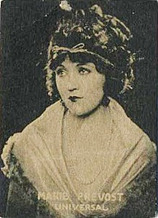
Marie Prevost (November 8, 1896[1] – January 21, 1937) was a Canadian-born film actress. During her twenty-year career, she made 121 silent and talking pictures. Prevost began her career during the silent film era. She was discovered by Mack Sennett who signed her to contract and made her one of his "Bathing Beauties" in the late 1910s. Prevost appeared in dozens of Sennett's short comedy films before moving on to feature length films for Universal. In 1922, she signed with Warner Bros. where her career flourished as a leading lady. She was a favorite of director Ernst Lubitsch who cast her in three of his comedy films; The Marriage Circle (1924), Three Women (1924) and Kiss Me Again (1925).
· Lottie Pickford·

Lottie Pickford (June 9, 1893 – December 9, 1936) was a Canadian-born silent film actress and socialite. She was the sister of fellow actress Mary Pickford and actor Jack Pickford. One of her best known roles was in The Diamond from the Sky directed by William Desmond Taylor in 1915. Pickford's career is often overshadowed by that of her siblings and though she was a notable figure in the 1920s, her films and role in the Pickford acting family is now largely forgotten.
· Vina Fay Wray.

Vina Fay Wray, September 15, 1907, Cardston, Alberta, Canada. August 8, 2004 (aged 96) New York City, U.S. Vina Fay Wray was a Canadian/American actress most noted for playing the female lead in the 1933 film King Kong as Ann Darrow. Through an acting career that spanned 57 years, Wray attained
international renown as an actress in horror movie roles. She was one of the first "scream queens".
· Jack Pickford

Jack Pickford (born John Charles Smith; August 18, 1896 – January 3, 1933) was a Canadian-born American actor, film director and producer. He was the younger brother of actresses Mary and Lottie Pickford.
After their father deserted the family, all three Pickford children began working as child actors on the stage. Mary Pickford later became a highly popular silent film actress, producer and early Hollywood pioneer. While Jack also appeared in numerous films as the "All American boy next door" and was a fairly popular performer, his popularity never matched that of his sister's. By the late 1920s, his career had begun to decline due to his penchant for partying and frequent use of drugs and alcohol. In 1933, Pickford died in Paris of progressive multiple neuritis, aged thirty-six.
· Joseph Wiseman.
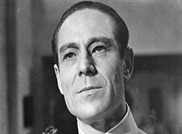
Joseph Wiseman (May 15, 1918 – October 19, 2009) was a Canadian theatre and film actor, best known for starring as the villain Julius No in the first James Bond film, Dr. No, his role as Manny Weisbord on the TV series Crime Story, and his career on Broadway. He was once called "the spookiest actor in the American theatre".Born in Montreal, Quebec, Canada to Orthodox Jewish parents, Louis and Pearl Rubin (née Ruchwarger), Wiseman grew up in New York. At age 16, he began performing in summer stock and became professional, which displeased his parents.
· Marjorie Ann Guthrie.

Born Marjorie Ann Guthrie in Winnipeg, Manitoba, Canada. she was the first-born child of a grain merchant born in Simcoe, Ontario. She entered show business at age 8 or age 10, as one of the Winnipeg Kiddies, a troupe of child performers who toured Canada and the United States. She danced and sang with the troupe until too old to continue; then at age 17, in December 1921, she went to San Francisco and joined Thelma Wolpa in amateur vaudeville comedy. Thelma White later gained immortality as the blowsy Mae in Reefer Madness. According to the New York Times (August 11, 1924), Marjorie White married Eddie Tierney on August 10, 1924 in Greenwich, Connecticut. Spouse(s)Edwin J. Tierney (1924-1935; her death)in car crash.
3 notes
·
View notes
Text
Movie Review: The Report
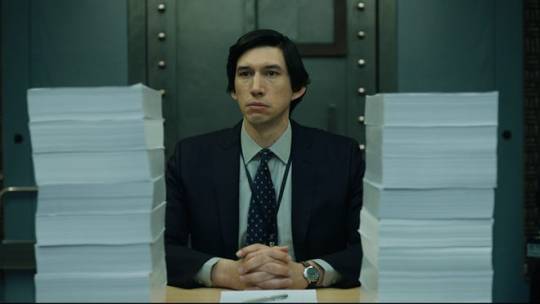
Shortly after 9-11, the CIA and FBI implemented a program of torture for suspected terrorists. Years later, it was determined that these methods had not resulted in a single piece of actionable intelligence that the U.S. did not already possess. In the time between, dozens of people were subjected to such treatment as being doused naked in freezing water, kept awake for days, bound in contorted positions, and being sexually humiliated. Most knew nothing, and some were innocent of any crime. Those who were guilty offered nothing usable. These are facts, impervious to any political leanings. It is this attitude of dry, clinical truth, mixed with just the right amount of emotion from star Adam Driver, that makes The Report an engaging film.
If your definition of “engaging” equates with “exciting”, you’ll want to scroll on by. Driver plays Daniel Jones, who, at the behest of Senator Dianne Feinstein (Annette Bening), led the investigation into the black sites where torture was performed after the CIA destroyed their tapes, which is not generally something people with nothing to hide do. He is a detail-oriented man: he reads through every page of every document available, insists on investigating even the smallest possible leads, and has a very difficult time giving up on a point when he knows he’s right. In other words, he’s exactly the kind of person you want if you’re going to go poking at an organization that is notorious for being secretive and defensive. He is not, as some will say, anti-American, having changed his classes to National Defense the day after the attacks. Driver’s removed style of acting, in which any display of emotion always comes as a surprise, fits the character well.
We know very little of his personal life, beyond the fact that he once had a relationship, which he no longer does due to spending his time at work. He’s eventually helped in his work by a disgusted and unwilling participant in the program (Tim Blake Nelson) and Ali Soufan (Fajer Al-Kaisi), a counter-terrorism expert whose years of experience and conviction that only relationship building yields good info are dismissed by the people calling the shots. Opposing him: a bevy of rotating CIA officials, all of whom seem aware of the flaws in the program but only care about protecting their tribe. These include a number of notable actors: Maura Tierney as a stand-in for Gina Haspel, Michael C. Hall, Jennifer Morrison, and Ted Levine. The latter, as real-life CIA director John Brennan, actively tries to smear Jones’ name in an effort to discredit his work, framing him for hacking into CIA servers.
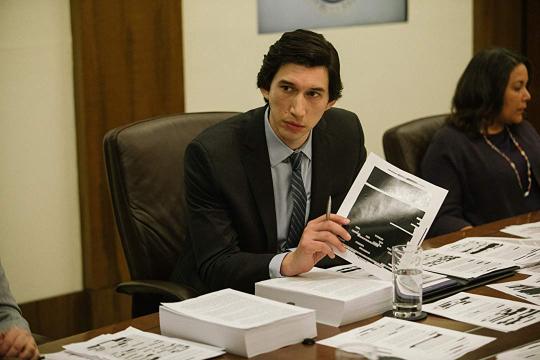
The things that took place at the black sites are shown in incredible detail, to the point where the squeamish may have a difficult struggle with the film. The “enhanced interrogation techniques”, the government’s euphemism for torture, do not consist of the stuff you see in movies---there are no beatings, no fingernails are ripped out. Prisoners such as Abu Zubaydah (Zoudi Boueri) are bound naked, placed in spaces too small for humans, screamed at constantly, kept awake with heavy metal music, drenched with freezing water. The two people behind most of the torture are psychologists who swear their methods work, even though none of their training is in interrogation. James Mitchell (Douglas Hodge) and Bruce Jessen (T. Ryder Smith) at first seem like they might really believe abuse works in getting information. This impression crumbles as the movie continues and they take evident pleasure in heaping pain on detainees, insisting the torture continue long after it has been proved useless. When confronted by investigators and asked point-blank why they are continuing if it hasn’t worked, Mitchell all but confesses it is more about revenge than effectiveness. Later, the two toast their success, and it is clear they aren’t talking about all the information they haven’t gotten. I find in digging into the true story that they made tens of millions of dollars as contractors doing this. Imagine having people like these for your psychologist.
Writer-director Scott Z. Burns and his team of producers, which include Steven Soderbergh, have gone to incredible lengths to accurately portray both the torture and the investigations. Some liberties have been taken---19 senate staffers have been reduced to Jones and a few composite characters, and of course some lines are there for dramatic effect---but digging into the real details shows a surprising level of accuracy. One gets the sense they are going against the cultural grain. The irony is they’ve made a movie accurately depicting the uselessness of torture, and it is usually movies and their dramatic exaggerations that make us think torture works. The movie flies in the face of a political ideology that equates violence with strength, and does so by sticking to the facts. Is it entertaining? It’s my job to answer that question. I would say it is effective. Those who need to see it probably won’t, and may not believe it if they do.
Verdict: Recommended
Note: I don’t use stars, but here are my possible verdicts.
Must-See
Highly Recommended
Recommended
Average
Not Recommended
Avoid like the Plague
You can follow Ryan's reviews on Facebook here:
https://www.facebook.com/ryanmeftmovies/
Or his tweets here:
https://twitter.com/RyanmEft
All images are property of the people what own the movie.
10 notes
·
View notes
Text
Have been realising that for all the travelling one does - the aftermath of what it meant to you is borne alone, no matter how many places you have been.
In other words, it means nothing to anyone else. It becomes only one of those other things you speak extensively of but which no one else that you meet may share in with you; because they were there at a different time, both of their experience and timing. Sometimes you exist in the same place as someone else and you do not know it because you had not met them; often what someone took from a place, where they went, what they did, and who with, are completely different to you -
It doesn't matter, or hardly matters, to anyone else I've met, this travelling done - the lingering senses are due me and not they. It doesn't make me more connectable; it makes me more obscure for the things I felt are mine own, and alone -
Watched Leave Her to Heaven last eve. The first film noir I've seen in colour. I wish I'd written down how I felt after watching it; it seems to have left me now. There's a way about the colouring, that deep saturation and rich tone of hue, that communicates its age as one that's gone past, almost like a fully-coloured version of sepia. There's something that catches hold of you about it, something deep in the sensing. It's flawlessly named, too. A close adherence - of everything in it, somehow. Gene Tierney is exquisite.
Something that struck me about it, though, is how women are always, somehow, portrayed as unfailingly flawless - out of the bath; swimming; having just woken up - never a moment without her immaculate make-up and red lipstick, that somehow, magically never seems to budge. Not even to come off even a little bit on the man when she kisses him.
And also of the costuming - equally superb. I loved everything they wore. Really the whole thing is a feast for the eyes. The somehow-soft focus, the simultaneous sharpness of grain and clarity -
Something else I noticed, too, is that it seems to me women had deeper voices then?... I'm not sure if this is merely illusory or if it has some truth in it, but their voices remind me of mine - I tend to think it's relatively low in comparison.
2 notes
·
View notes
Photo

A druid in her natural environment.
#surrounded by death and decay lmao#tierney grain#stupiderist art#i felt like drawing something a little diff tonight
11 notes
·
View notes
Text
ER - Saison 15 [2008-2009]
Où comment tenir bon sur la dernière ligne droite. Faire du fan-service intelligent. Et finir en beauté.

En tout cas, c'est le bon souvenir que je garde de cette ultime saison qui, peu à peu, à réussir à reconstruire une dignité à #ER en puisant dans le passé sans forcément renié ses quinze années d'évolution. Pour la dernière fois, voyons si mes souvenirs sont bons...
15.01 Life After Death
Par amour du symbole, la saison débute avec une scène qui a tout l'air de dire : "allez, laissez-nous sortir d'une gueule de bois qui a duré trois saisons..."

#ER a souvent mis ses héros en danger lors de season premiere ratés car sans vrai suspense. Que ce soit Pratt et Chen dans le 11.01, Abby dans le 13.01 ou Neela dans le 14.01, on savait qu'ils allaient s'en sortir. Le 15.01 frappe fort car il va jusqu'au bout.
Si on m'avait dit que Pratt allait y passer lors de la 12ème saison, j'aurais dit bon débarras. Là, l'émotion est au rendez-vous car la s14 aura au moins réussi à en faire un personnage intéressant et un chef d'équipe crédible. Son agonie est cruellement bien retranscrite.

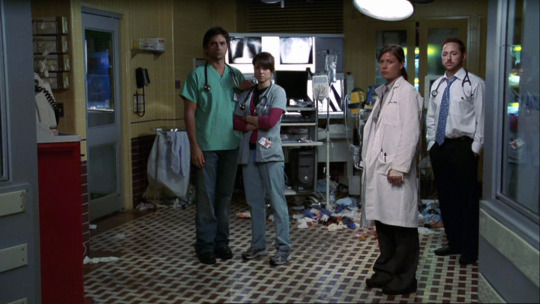
C'est tout sauf original mais c'est exécuté avec un savoir-faire, un sens de la structure et du crescendo émotionnel qu'on avait pas vu depuis très longtemps. Et c'est l'occasion parfaite de ressouder une équipe resserrée au début de cette dernière saison.
En particulier pour Morris qui, après une légère rechute en s14, va devoir à nouveau prouver qu'il est celui sur lequel compter. Avec le départ imminent d'Abby et Neela coincée en chirurgie, il est le titulaire le plus ancien à parcourir le County. Et il va être à la hauteur.


Il m'a fallu une demi-seconde pour retrouver la Abby que j'aime. C'est fou cet éclair de lucidité de la part des scénaristes. Ils pensent même à offrir à chaque personnage secondaire un moment touchant. On est déjà dans l'hommage bien dosé. Le début de la fin.
Greg, on aura pas toujours été copain mais je vois ta tronche tous les jours depuis trois mois, je t'ai supporté dans ton meilleur (s9, 13 et 14) et surtout dans ton pire et même si le jeu de Mekhi Phifer aura rarement su me convaincre en 135 épisodes, restes en paix.


15.02 Another Thursday at County
Pour sa dernière rentrée des classes, #ER propose un mélange reboot/greatest hits qui annonce la couleur de la saison, introduit une nouvelle génération et rappelle son talent pour passer le flambeau.
Le County est le personnage principal de la série et, dans une version amélioré du nouveau chef venant semer la zizanie, le Dr Banfield symbolise à la fois le passé et le futur de l'hôpital. Angela Bassett est en surjeu total mais apporte une belle énergie et une vraie classe.


Même chose pour les 4 nouveaux internes qui, tout en rappelant que NBC essaye de concurrencer #GreysAnantomy, représentent chacun un mix de différents archétypes vus dans #ER. Des gimmicks nécessaires pour lancer un nouveau cycle d'apprentissage.
On y retrouve notamment Emily Rose (futur star de #Haven), Julian Morris (aperçu dans #NewGirl), Victor Rasuk (#HowtoMakeitinAmerica) et bien sûr Shiri Appleby (#Roswell #Unreal) qui était déjà apparu dans le pilote de la série en tant que jeune patiente.


Les bébés docteurs renforcent le statut des vétérans et nous font mieux apprécier Tony (oui, je suis le premier surpris), un Morris en pleine dépression et une Sam qui a son meilleur épisode depuis longtemps. Reste encore beaucoup de boulot à faire sur Brenner...
Bien sûr, le coup du virus contagieux, c'est pompé sur "Exodus" (4.15) et "Lockdown" (8.22) mais on s'en fout parce que la 15ème saison est là pour recycler avec talent et nous rabâcher que les médecins changent mais pas le County.
En tout cas, c'est la dernière fois que l'on aperçoit ce bon vieil Anspaugh. Big up à John Aylward qui depuis la 3ème saison et pendant 75 éps en tout, aura su être une figure aussi autoritaire que rassurante, présent lors des moments cultes, de "The Storm" à "May Day".

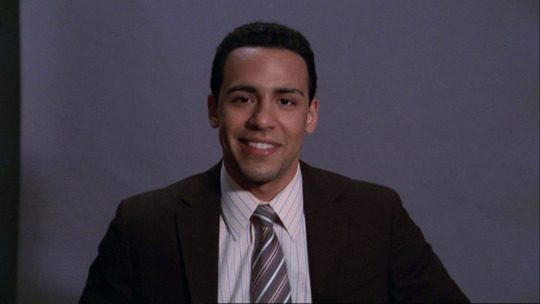
15.03 The Book of Abby
L'un des plus beaux personnages de la série (et l'un de mes favoris à la télévision) a le droit à un départ digne de ce nom. À nouveau, la 15ème saison propose un best-of et pioche ici dans les meilleurs adieux pour honorer Maura Tierney.
David Zabel nous rappelle qu'il était à l'origine de "Orion in the Sky" (8.18) et emprunte beaucoup à cet épisode culte tout en l'adaptant à ce qui fait d'Abby un personnage particulier. Drôle, émouvante, a bit nuts..


Tout son long parcours est revisité lors de cette dernière garde où j'ai retrouvé tout ce qui a rendu inoubliable les 190 épisodes passés en compagnie d'Abby : de son appartement à son amitié avec Neela en passant par son passé d'infirmière, sa mère et sa relation avec Luka.
À l'exception de la voix-off en intro, j'ai trouvé qu'il n'y avait pas une seconde de trop, que les répliques étaient parfaites et j'ai pleuré régulièrement. J'ai pleuré quand elle dit au revoir à Neela. Quand elle passe le flambeau à Morris. Quand elle danse avec Frank...


J'ai pleuré car la série a bonne mémoire et nous ressort le score du départ de Mark, Carol et Carter et qu'en utilisant Haleh en gardienne des souvenirs, on peut lire tous les noms qui ont parcouru ces couloirs et y ajouter ceux de Lockhart et Kovac, à la place qu'ils méritent.
J'ai pleuré car je suis un fan et qu'on m'a offert du fan service de qualité. Et parce qu'après bientôt cinq mois à vous embêter avec ça, je ne pourrais plus inonder votre feed de Maura Tierney. Quel voyage depuis "Abby Road" (6.12).
Merci pour tout Abby. Keep your head up...

15.04 Parental Guidance
Angela Bassett porte sur ses épaules un épisode faiblard qui prouve que la série doit encore se débarrasser de mauvaises habitudes pour retrouver son charme d'antan.
Pourtant, ça commence bien avec chaque titulaire qui doit former un interne mais très vite, les "mentors" s'égarent: Tony reprend sa casquette de Uncle Jesse face au piercing de Sarah, Morris a peur de sortir avec une call-girl et Brenner continue son flirt agressif avec Neela...
Alors on se repose sur les guest-stars : l'excellente Molly Price déjà venu dans #ER lors du crossover avec #ThirdWatch (8.19) et Glynn Turman (#TheWire) vétéran du petit écran. Dommage que leurs intrigues respectives manquent autant d'originalité et d'impact.


15.05 Haunted
Cela faisait longtemps qu'on avait pas eu d'épisode spécial Halloween (depuis le 10.05 je crois) et le retour de cette tradition est un peu manqué. Juste un prétexte pour ouvrir le défilé des anciens avec un personnage toujours aussi fade, même amputé...
La nonchalance de Shane West n'a toujours aucun effet sur moi et un énième triangle amoureux autour de Neela est synonyme d'ennui total. Ça devient de plus en plus frustrant d'entendre dire qu'elle est une grande chirurgienne sans jamais la voir au bloc...


Le reste est un remake sans éclats de trucs vu et revus : l'infirmière qui reprend ses études de médecine, le pédiatre qui essaye de redonner le sourire à un gamin (oui je sais Tony n'est pas pédiatre mais c'est tout comme) et un suspense à rallonge autour du secret de Banfield..
Au moins, les graines sont plantés pour une mini-rédemption de Brenner qui, peu à peu, passe du connard machiste au connard "mais c'est pas sa faute car il a eu une enfance difficile". Le genre d'épisode qui me fait dire qu'il était grand temps de plier les gaules.


15.06 Oh Brother
Un bon petit épisode vintage qui, sans forcer le mélo, continue de parler transmission de savoir et traumatismes en tout genres. Le duo Morris/Banfield fonctionne bien et est le moteur inattendu de cette dernière saison.
Même si Sam Jones III n'est pas beaucoup plus expressif que Mekhi Phifer, Chaz Pratt est bien utilisé comme fantôme de son frangin et symbole d'une énième génération venu remplacer la précédente. Le cycle de la vie pour citer Rafiki.
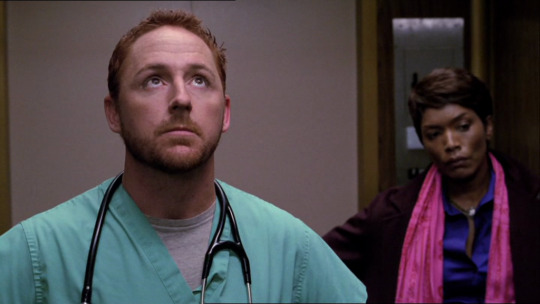

Le Tony que je peux supporter avec plaisir est le Tony qui s'occupe d'un vétéran du Golfe SDF. Le Tony dont je ne peux plus, c'est celui qui se retrouve au milieu d'un triangle amoureux (le 512ème) entre Sam et Shiri Appleby.
En tout cas, il faut vraiment saluer le boulot de l'équipe de casting qui, comme si la présence d'Angela Bassett n'était pas déjà un cadeau, enrôle Courtney B. Vance dans le rôle de son mari.
Et pour interpréter l'histoire simple mais touchante entre un boxeur et son père, embauchent Chadwick Boseman (#BlackPanther) et Carl Weathers (dans ce qui est presque un sequel à #Rocky).


15.07 Heal Thyself
Un "very special episode" qui commence sur une note plein de gravité avec le retour de l'ancien logo et Eriq LaSalle nous annonçant le décès de Michael Crichton, le créateur de la série (et de #JurassicPark et #Westworld).

Il y a de nombreuses façons de faire revenir Anthony Edwards pour une apparition nostalgique et David Zabel a vraiment réussi à trouver la plus sensible et organique. Le Dr Greene revient pour servir l'histoire du Dr Banfield et non l'inverse.
Le background de Catherine n'est donc pas juste une excuse pour nous amener à ce saut dans le passé. Mark est donc en retrait, tel qu'on s'en souvient : un médecin exemplaire qui accompagne avec pudeur le deuil d'une famille.

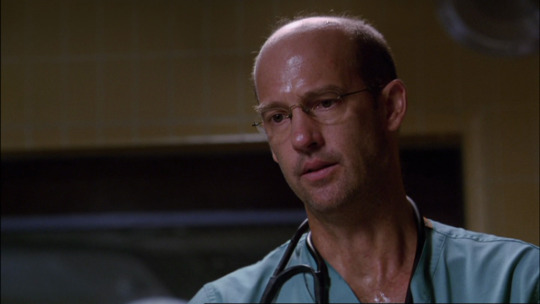
Même si on a des caméos qui font plaisir de la part de Laura Innes et Paul McCrane, c'est bien Angela Bassett qui est au centre de toutes les attentions et qui est servi par le script et la réal de Zabel.
C'est donc un bel exploit que d'avoir réussi à juste nous proposer un très bon épisode de #ER sans être débordé par la nostalgie abusive. Le montage est d'une grande précision et le flashback (qui a lieu autour du 8.17 si mes calculs sont bons) ne fait pas d'erreur de continuité.


Les clins d'oeils sont discrets (la chemise culte de Mark, le score) et sont juste de petits bonus qui ne distraient pas. De toute façon, on est trop occupé à être ébloui par ce que proposent Angela Bassett et Courtney B. Vance, impeccables.
Il y a même autour de cette intrigue centrale des choses en périphérie qui rappellent l'âge d'or de la série, comme le jeune Andrew en héritier du jeune Carter. Julian Morris est clairement le plus convaincant des 4 nouveaux internes.


Bref, merci à Zabel de ne pas s'être planté sur ce coup-là et d'avoir éviter les nombreuses maladresses qui le guettait avec ce genre d'exercice. Débarrassé des attentes et aidé par une écriture solide, c'est un mini tour de force qui fonctionne encore mieux lors d'un rewatch.

15.08 Age of Innocence
Je suis partagé : d'un côté, je me dis que lui inventer un background de victime de pédophilie, c'est un moyen paresseux de rendre Brenner attachant et de justifier son comportement ignoble de Dom Juan...
D'un autre côté, la manière dont on nous amène à ce monologue final, la puissance de David Lyons dans cette scène, c'est du grand #ER. Et réussir à faire du grand #ER avec des personnages que je croyais détester, c'est un petit miracle.


Le grand pardon ne s'arrête pas à Brenner puisqu'il s'agit également du meilleur épisode de Tony Gates (mon pire ennemi) depuis son apparition dans la série. Enfin le background militaire du personnage est utilisé à bon escient et sans passer par la case "Full House"...
Janine Sherman (l'une des meilleures scénaristes des dernières années) réussit donc à soigner des personnages en roue libre depuis trop longtemps. Et par l'intermédiaire d'Andrew, elle redonne à Neela un vrai arc mentor/élève. C'était maintenant ou jamais.

15.09 Let It Snow
Ça démarre comme un hommage à "Blizzard" et le classique catastrophe de neige... et ça finit par être un hommage à une autre tradition moins glorieuse : les mésaventures d'Alex Taggart...
Cardellini et Stamos s'en sortent mieux que prévu dans leur duo Doug/Carol du pauvre mais j'en peux plus de voir leurs ados se foutre dans le pétrin et entraîner des cliffanghers à la noix. De Sarah ou Alex, je ne sais même pas lequel est le pire...
J'ai largement préféré passer du temps avec un autre duo, celui formé par Banfield et Morris. Un huis-clos intimiste, finement écrit et où on peut se régaler devant Angela Bassett ivre qui chante Joan Jett. Plus mémorable que le drama des urgences finalement...


15.10 The High Holiday
Pour son dernier cadeau de Noël, #ER nous offre ce qu'elle fait de meilleur : des cas médicaux avec une résonance sociale, une équipe soudée et un bon équilibre entre moments graves et légers. À l'ancienne quoi.
Quand je vois comment la série nous parle des immigrés et des vétérans, comment elle a su faire évoluer son idéalisme et ses combats sur + d'une décennie, entre l'administration Clinton et Obama, je suis un peu curieux de voir de quoi elle serait capable sous Trump, aujourd'hui.
Avec la superbe Robin Weigert (#Deadwood), on aborde l'adoption par les couples homosexuels sans jamais tomber dans le didactisme. C'est une histoire médicale traité avec sensibilité et qui a un écho sur l'arc du Dr Banfield.


J'ai aussi remarqué que, pour la 1ère fois depuis peut-être la S5, il n'y a aucun personnage de trop et aucun personnage que je ne déteste. Ça aura mis le temps mais les scénaristes ont enfin compris comment manier leur cast. Je suis même réconcilié avec Brenner, voilà c'est dit.
Et comme miracle de Noël, on a un nouveau retour de notre réceptionniste favori ! Jerry s'emmerdait en Alaska, ce qui est un clin d'oeil à l'annulation de "Men in Trees", la série où Abraham Benrubi était barman le temps de deux saisons.

15.11 Separation Anxiety
Quelle bonne idée d'avoir engager Justina Machado (#SFU #onedayatatime) comme love interest de Morris ! Elle apporte une énergie dingue et bénéficie d'un personnage vivant, bien écrit et dont la relation avec le médecin commence très bien.
Par contre, j'avais pas du tout besoin d'un flirt John Stamos/Shiri Appleby. J'ai eu ma dose de triangle amoureux bidons et de médecins qui couchent avec des étudiantes, #ER, merci bien. C'est con parce que Tony était devenu mon pote...
L'épisode se concentre surtout sur Banfield et son désir d'enfant. Ce qui n'a rien d'original, est un peu précipité et a déjà été vu avec Jeannie Boulet. Mais Angela Bassett fait le boulot et c'est l'occasion de revoir une dernière fois le Dr Janet Coburn.

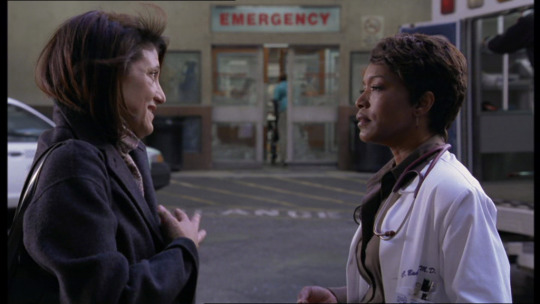
15.12 Dream Runner
#ER ne pouvait pas tirer sa révérence sans une nouvelle expérimentation. Ce mélange de "Groundhog Day"/"Run Lola Run" est un noble échec et tient donc plus de "Hindsight" (9.10) que de "Time of Death" (10.06) ou "Body & Soul" (12.13).
C'est une bonne idée de faire un Neela-centric au moment où le personnage - qui est désormais le plus ancien du cast principal - est à un tournant. Une bonne occasion de parler orientation et de nous offrir un dernier épisode focalisé sur la chirurgie.


Une bonne excuse aussi pour une visite brève mais délicieuse d'Alex Kingston. Comme pour son mari dans le 15.07, l'apparition de Lizzie est au service du présent plutôt que d'être purement nostalgique ou gratuite. Elle a vraiment sa place face à Neela, sa jeune héritière.
Mais est-ce que tout ça bénéficie vraiment de cette structure en forme de triple hypothèse et de cette voix-off à la #GreysAnatomy ? Pas forcément mais même s'il est à peine réussi, je salue l'essai. #ER était une série de network qui essayait sans cesse de dynamiter sa forme.
Et en tant que dernier rejeton de cette série d'expérimentations, "Dream Runner" ne manque donc pas de charme et redore presque l'image de Neela. Dommage que sa coucherie avec Brenner soit le dernier acte d'un épisode qui s'était refocalisé sur sa carrière...


15.13 Love is a Battlefield
Un titre naze pour un épisode moyen centré sur des histoires de coeur sans intérêt, surtout si près de la fin. J'imagine que c'est un hommage à une autre spécialité du #ER sous Zabel : le soap soporifique.
Mais si on zappe tout ce qui concerne le couple Neela/Brenner ou le triangle Sam/Tony/Daria (c'est à dire les 3/4), on peut se délecter d'une enquête mené par Morris et Claudia, le seul couple un minimum captivant.
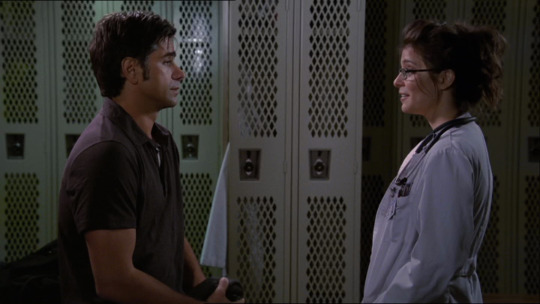
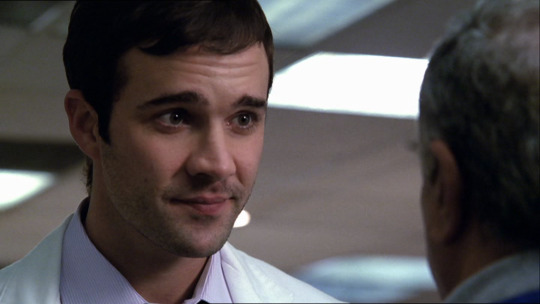
À moins que vous ne rêviez d'une B-story avec Brady qui doit raser le dos d'un client très poilu ? Si oui, vous êtes le genre qui a dû adoré le couple Jane Figler/Dusty Crenshaw ? Merde, concentrez-vous les gars, il vous reste plus beaucoup de temps...
On notera la présence de la vétérante Debra Mooney (#Everwood) après une apparition dans un autre rôle en s5 et la dernière consultation du Dr Myers (Michael B. Silver), psychiatre du service depuis la deuxième saison.
J'en profite pour faire un big-up à Chuny Marquez (Laura Cerón) qui est non seulement l'infirmière qui a fait le plus d'apparitions dans la série mais aussi la 3ème actrice a être apparue dans le plus grand nombre d'épisodes (219 !) juste derrière Noah Wyle et Laura Innes.
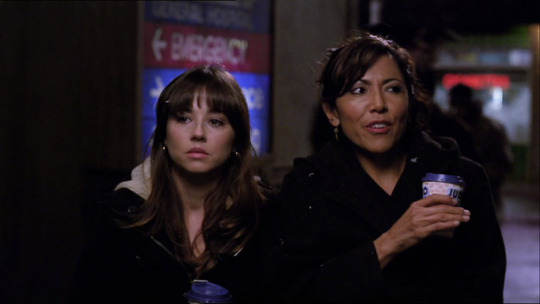
15.14 A long, Strange Trip
Un épisode ingénieux qui permet de rendre hommage à l'Histoire du County, à l'évolution de la médecine d'urgence et à la capacité sans cesse renouvelée de Joe Sachs pour écrire des patients touchants.
Le dernier baroud d'honneur d'une ancienne légende du County m'a fait verser une larme. On a presque l'impression que l'équipe en profite pour saluer Michael Crichton. Et le retour du Dr Morgenstern (William H. Macy) est aussi réjouissant que bien pensé.


Les flashbacks en 1968 sont parsemés, plutôt élégants et donnerait presque envie d'un spin-off historique. En tout cas, la 15ème saison continue son travail minutieux sur la mémoire, l'héritage et le retour aux sources.
En plus de ce voyage temporel, le présent offre des cas passionnants : une afro-américaine qui risque six mois de prison pour avoir volé des médicaments à cause d'une sécu pourrie et la victime d'une tuberculose mal diagnostiquée. Du très bon #ER dans les deux cas.
Seul bémol : un énième drame familial avec Sam et une sœur sortie de nulle part parce qu'on avait pas eu assez avec le fils, l'ex-mari et la grand-mère. Même le charme de Shannon Woodward (#RaisingHope #Westworld) ne m'a pas empêché de bailler poliment.


15.15 The Family Man
Pour des histoires de familles intéressantes, il vaut mieux se tourner vers cet épisode réalisé par Eriq LaSalle où chaque cas médical est traité avec sensibilité, en particulier celui de la jeune Lucy (Ariel Winter pré-#ModernFamily).
Louis Gossett Jr. vient faire la leçon à John Stamos dans une intrigue aussi simple que touchante, juste un vieillard qui accepte sa propre mortalité. Il suffisait tout bêtement de bons patients pour rendre Tony et Brenner supportable.
Big up aux secouristes Dwight Zadro (Montae Russell) et Doris Pickman (Emily Wagner) qui, depuis la première saison et pendant plus de 150 épisodes, auront accompagnés les patients au County. Merci à eux et leurs collègues Olbes, Dumar, Bardelli, Morales et j'en passe !


15.16 The Beginning of the End
Qui de mieux que John Carter pour célébrer le début de la fin ? Même si le drama est un peu forcé pour justifier le retour de l'enfant prodige du County, le plaisir de retrouver mon personnage favori suffit à faire passer la pilule.
Et à travers celui qui nous a fait découvrir les urgences au tout début, on réalise à quel point elles ont changés en son absence. Encore une occasion de revisiter la mythologie du County soit avec auto-dérision soit avec révérence.


Si on met de côté l'aspect éculé du "médecin qui doit lui-même affronter la maladie", le retour de Carter est donc traité avec réalisme, sans en faire des caisses et en caressant les fans de mon genre dans le sens du poil. Noah Wyle m'avait sacrément manqué.
Ah et voilà de quoi conclure le débat Carby/Lubby pour de bon (même si on me la fait pas à moi) :



Le reste de cet épisode spéciale Saint-Valentin parle justement d'amour et, même si je me contrefous toujours des couples Neela/Brenner et Tony/Sam, j'ai toujours autant de plaisir à suivre Morris et Claudia, surtout qu'il permet ici d'aborder les violences policières.
Bien que pas toujours adroit dans ses tentatives d'humour et bien que je me serais largement passé des deux montages musicaux lourdingues, je suis donc ravi du retour de Carter. À défaut d'avoir un bon épisode, on retrouve un bon vieux personnage.
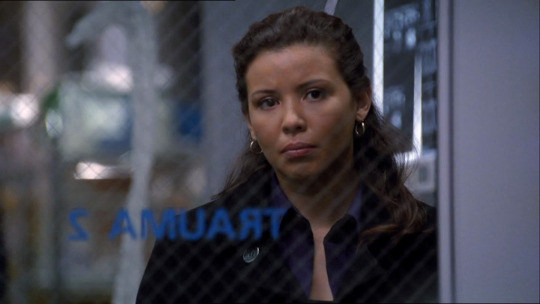

15.17 T-Minus 6
La "première" garde de Carter se fait dans un mélange de drama et d'auto-dérision qui colle bien au personnage et lance habilement le crépuscule de la série.
Par petites touches, on revisite toute la mythologie John Carter, de ses débuts en chirurgie à la mort de Lucy en passant par l'Afrique et, dans une scène coupée d'un joli dialogue avec Banfield, une référence à son ancien mentor...
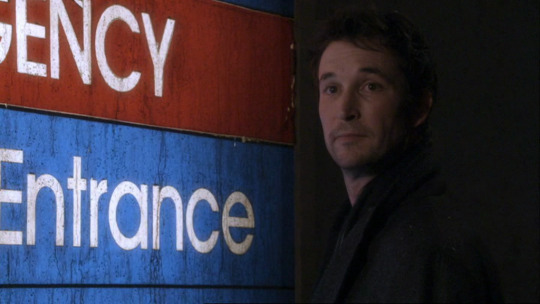

Avec Rod Holcomb derrière la caméra (il avait réalisé le pilote), Zabel et Zwerling mijotent du recyclage qui s'assume (Neela/Dubenko en mode Carter/Benton, Brenner en mode Doug Ross) et renforce l'impression de boucle plutôt que d'être un signe de paresse.
Bien sûr, la série ne pouvait pas se terminer sans un dernier arc "médecin dont un membre de la famille a des problèmes" et, bien sûr, ça tombe sur Sam. À défaut d'être original, ça permet à Cardellini de jouer autre chose que le flirt avec Stamos.

15.18 What We Do
Là où le live permettait au docu "Ambush" (4.01) d'être dans le feu de l'action, ce docu là se concentre sur des faces à faces et dresse un portrait intime et amoureux du personnel des urgences.
Si le procédé est vu et revu (j'en ai même fait un article : http://goo.gl/5p18Z9 ), il est utilisé à petites doses et c'est avant tout un moyen de rendre hommage à l'équipe et d'offrir à chaque acteur une chance de briller en dehors de la formule habituelle.


En particulier le petit personnel, mis en avant comme rarement auparavant. L'occasion de saluer nos camarades les plus familiers, fidèle au poste depuis plus de 200 épisodes : Haleh (Yvette Freeman), Frank (Troy Evans) et bien sûr Jerry (Abraham Benrudi). Les vrais vétérans.
Il se dit aussi beaucoup de choses sur le fonctionnement des urgences (le lieu) et d'Urgences (la série). Et c'est super d'avoir un Carter mélancolique. Jusqu'au bout, il aura été notre guide et comme cette fin me rend mélancolique moi aussi, l'impact est bien là.
Mais finalement (et Carter est aussi surpris que nous), c'est bien Morris qui donne le ton. Même si ce qui arrive à Claudia était ultra prévisible, elle permet de mesurer la maturité d'Archie. Scott Grimes livre sa performance la plus juste.
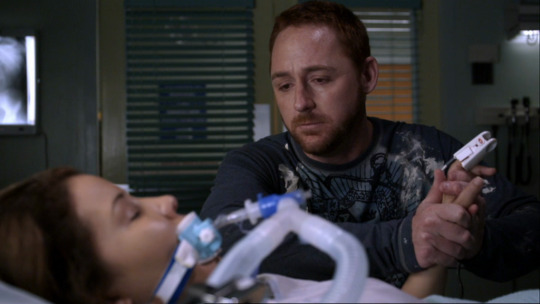
15.19 Old Times
Même le fan le plus optimiste n'aurait pas osé rêver d'un meilleur cadeau. Avec une histoire très solide de dons d'organes, on retrouve de vieux amis et pas juste pour des caméos gratuits.
Presque 10 se sont écoulés depuis qu'on a vu notre couplé préféré et il faut cinq secondes à Margulies et Clooney pour retrouver leurs personnages cultes sans décalage bizarre et avec ce qu'il faut d'autodérision et de clins d'oeils au temps qui passe.

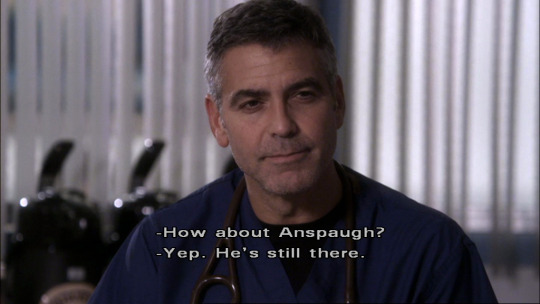
Il y a même dans la scène finale le retour du thème musical Doug/Carol. John Wells a une mémoire de dingue. Son meilleur épisode depuis longtemps (le dernier étant "Canon City", c'était pas difficile). https://www.youtube.com/watch?v=dbmDmwxMlnc …
Bien sûr, si vous avez un peu suivi le thread, vous vous doutez que la réunion qui m'a le plus réjoui, c'est celle du meilleur duo de la série. Elle se fait à la cool, avec une maîtrise total de ce qui fonctionne dans la dynamique entre mentor et élève.
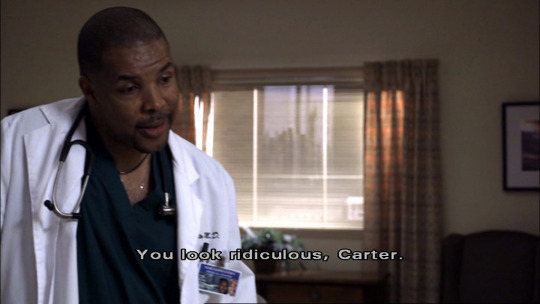
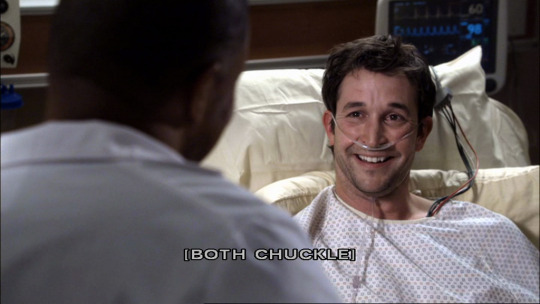
Même Cleo a le droit à une mention ! Et j'ai pris un coup de vieux quand j'ai appris que Reese avait 13 ans et puis j'ai réalisé que maintenant, il aurait 23 ans et ça m'a un peu déprimé...
Comme si on avait pas déjà été gâtés, la série se paye le luxe d'embaucher Susan Sarandon et la légende Ernest Borgnine (dans l'un de ses derniers rôles).
Même avec tout ça, l'épisode n'est jamais chargé, il tient la route. À l'exception peut-être de l'intrigue de Banfield. C'est bien de conclure son arc mais là pour le coup, le bébé abandonné qui lui tombe dans les bras, c'est un peu précipité.


15.20 Shifting Equilibrium
Là où le départ d'Abby était inspiré de "Orion in the Sky" (8.18), celui de Neela puise plutôt du côté de "Such Sweet Sorrow". Même si le personnage aura été bien malmené pendant la période sombre de la série, c'est plus émouvant que prévu.
J'ai bien aimé la structure qui, en plus de soigner la sortie de Neela, permet d'insérer un clip-show (avec un clin d’œil à Gallant) et d'achever la rédemption de Brenner. Même si ça s'est fait un peu rapidement, il a joliment évolué depuis ses débuts minables.


On en profite aussi pour dire au revoir à la chirurgie et à Lucien Dubenko (Leland Orser). Quand il n'était pas occupé à être ambigu avec ses protégés, le chirurgien avait son charme et a été une figure pendant plus de 60 épisodes. Il termine en tout cas sur une bonne note.
Bon, même si je suis ravi d'entendre le score des retrouvailles Doug/Carol, on va pas se mentir, les retrouvailles Neela/Ray ne sont pas du même niveau. J'aurais presque préféré qu'elle termine avec Brenner plutôt qu'avec son ex-coloc relou mais bon, j'apprécie la référence.


Mais en vrai, le seul caméo valable, c'est celui d’Abby. Merci d'être passé Maura, surtout que l'amitié Abby/Neela aura été le point fort du #ER post-Carter.
Alors j'oublie les désastreuses saisons 13 et 14 où elle a fait n'importe quoi et je repense aux saisons 10 à 12 où Neela a été une figure attachante et rafraîchissante de la nouvelle génération (en particulier dans "The Student" ou "I Do"). Elle a mérité son nom au panthéon.
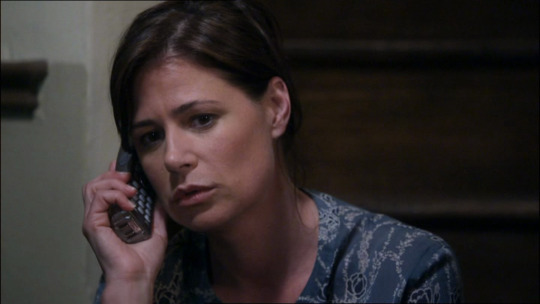

15.21 I Feel Good
Pour son avant-dernier épisode, #ER se repose sur son côté le plus humaniste et (comme l'indique le titre) feel good. Après tant de drama et de malheurs, ça fait du bien.
C'est donc sous forme de happy-end que se bouclent les arcs du cast principal : Banfield adopte, Morris lance une famille, Tony et Sam se réconcilient et Brenner accepte ses vieux démons. C'est aussi prévisible que satisfaisant. Surtout pour Archie et Claudia.
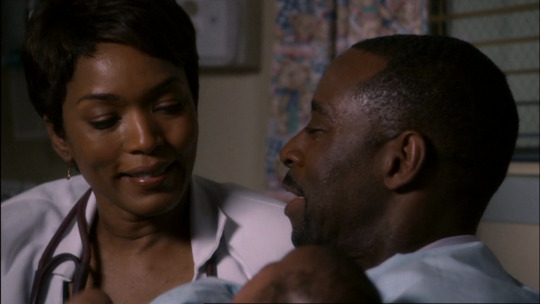

Et en toile de fond, on a donc le Camp DelCorazon, centre aéré pour enfants souffrant de problèmes cardiaques (il existe en vrai), ce qui permet à Joe Sachs de mélanger les états d'âmes des médecins et des patients. De faire du classique #ER quoi.
C'est un bon moyen aussi d'utiliser la voix de Scott Grimes et les "talents" de batteur de John Stamos (qui joue avec les Beach Boys à l'occasion). En fait, on a l'impression d'avoir une fête de fin de tournage pour l'équipe et leur joie est contagieuse.

15.22 ...And in the End
Remake du pilot, ce series finale est un best-of de tout ce que #ER sait faire de mieux. Une conclusion parfaite entre classicisme et nostalgie qui a bien compris que le personnage principal était le County Hospital.
Il était difficile de faire mieux que "The Letter" (8.20) et pourtant, avec cette garde de 24 heures qui brasse plein de générations différentes et ces nombreux parallèles avec le pilote (dont une réal de Rob Holcomb), ça valait presque le coup d'avoir six ans de plus...


Et comme dans le pilote, c'est Carter qui nous guide et qui, en même temps, guide Rachel. Ce qui boucle encore plus de boucles. Termine la série sur le thème de l’apprentissage et du passage de relai. Et nous offre une dernière réplique impeccable. "Are you coming, Dr Greene?"
L'ouverture du Carter Center est un bon prétexte pour une réunion d'anciens élèves qui sonne authentique tant les acteurs prennent du plaisir à se retrouver. Revoir Susan balancer des one-liners et Peter/Lizzie flirter est un beau cadeau.
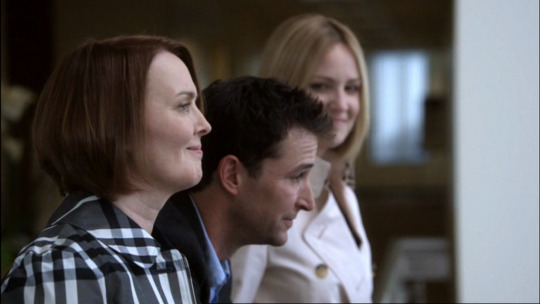

On a une conclusion à la saga Carter : une jolie scène avec Kem, un dernier échange avec son mentor, une dernière partie de basket. Moi qui était déçu de "The Show Must Go On" (11.22), j'ai été servi et en reprendrais presque pour quinze ans.
John Wells n'oublie pas de récompenser les "nouveaux" et on quitte le County en étant réconcilié avec Tony et Sam et en ayant confiance total envers le duo Banfield/Morris pour assurer les patients (tous très émouvants pendant cet épisode).


Alexis Bledel se révèle très crédible dans le rôle de la (dernière) nouvelle venue et je me dit que si NBC craque pour un reboot, je vois bien le Dr Julia Wise en chef des internes, avec Archie en chef des urgences et, bien sûr, Carter en directeur du County.
De toute façon, c'est le message de l'épisode : le soleil arrive après la pluie, patients et médecins vont et viennent et, au County comme dans la vie, tout recommence. On est que de passage. Et je suis content de toujours pouvoir compter sur #ER pour rendre meilleur le voyage.


#urgences#er#rewatch#nbc#maura tierney#mekhi phifer#scott grimes#parminder nagra#david lyons#angela bassett#linda cardellini#john stamos#noah wyle#anthony edwards#george clooney#julianna margulies#laura innes#eriq la salle
2 notes
·
View notes
Text
Bourbon: Origins, Tasting, and Recommendations
Whiskey comes in many forms, but bourbon is America's spirit
The origins of bourbon are both known and debated. We know early settlers in Virginia and Kentucky made use of the abundance of corn to distill their whiskey, but there are a variety of stories on who was first to put it in a new, charred oak barrel and to actually call it bourbon. No matter the exact origins of bourbon we now have a spirit that is all American to enjoy. Congress declared so in 1964 stating that bourbon is a "distinctive product of the United States." Score one for America.
We're joined this week by Bruce Tierney, all around aficionado and spirit consultant to Dekalb Bottle House. Tierney shares with us the history of bourbon, let's us know what it takes to call a whiskey bourbon, and offers some suggestions on affordable options to test the waters as well as some of the rarer bourbons to seek out. We also discuss what flavors to look for when tasting as well as common off flavors, and a quick course on how to taste your bourbon.
There's much more information on bourbon than we could cover in this show so we've included additional information and resources here. Side note, if you're used to sampling beer in 4 oz pours know that 4-5 1 oz pours of bourbon kick harder than you think. Proceed with caution.
Copper pot stills at ASW Distillery in Atlanta, GA (Photo: Thechadwix, CC BY-SA 4.0)
What makes a whiskey bourbon?
Must be produced in the United States
Many people mistakenly believe bourbon must be made in Kentucky but it can be made anywhere in the US. Several other countries support the American origin, but some do not. Be careful when purchasing overseas.
Must be made from at least 51% corn
Has to be aged in new, charred oak barrels
Can be distilled to no more than 160 proof. Higher proof distillation begins to strip flavors.
Has to be entered into the barrel for aging at no more than 125 proof
Must be bottled at 80 proof or more
There is no minimum age requirement for bourbon as long as it meets the above guidelines
Outside of these requirements there are several variations allowed such as wheated and "high rye" bourbons, bottled-in-bond, straight bourbon and blended bourbons.
How to begin your bourbon experience
Tierney has offered up his very detailed advice on how to get started with bourbon including notes for selecting a bourbon, glassware and tasting.
My first recommendation for someone new to bourbon is to start your experience by tasting standard bourbons from the major producers first before deciding if you want to branch out and try other brands. I recommend brands that tend to be between 90-100 proof. Yes, that may seem a bit hotter at first but they also tend to be more flavorful. The minimum permitted proof is 80 proof and at that point you are drinking a good bit more water than bourbon anyway!
If it seems intimidating to shell out the money to buy a bunch of different bourbons you are right! Although all of the major bourbon producers have a brand that costs in the $20-35 range it can still be a lot of money. Pick a couple that are of interest or are readily available in your area and start with those first. Don't try too many different brands to start with. Or if you are fortunate enough to live near a bar with a good bourbon selection start by tasting different bourbons a glass at a time if you don't want to commit to buying a full bottle. Any bourbon bar worth its name will have many if not all of the standard brands from the major distilleries. If they don't then you are in the wrong place!
Try to learn a bit about the different bourbons you have selected. The internet can be your friend here. I can personally recommend straightbourbon.com as a good source for information about bourbon and many other types of spirits. Remember all bourbon is made from at least 51% corn but what is the rest of recipe of grains, known as the mashbill, that makes up the bourbon? Most bourbon use either rye or wheat as the "flavoring grain" in addition to the corn and a little bit of malted barley when you are buying brands from the major distilleries. Many people think of rye as making bourbon a bit spicier although to meet it seems a bit earthier than spicier. Is it mostly corn with a little bit of rye? Buffalo Trace falls into this category. Or does it have a lot of rye? Four Roses Single Barrel is one of the higher rye content bourbons. Maybe make those two your first choices and see which you like better! Most other brands tend to fall somewhere in between. Or is it a bourbon with wheat as the flavoring grain? This type is a bit less common but still readily available. Basic options include Maker's Mark, Larceny and Weller. Perhaps start your journey with a rye bourbon and a wheated bourbon. After you have tried your choices several times you can decide which one you prefer and then try something more similar to see what appeals to you.
Try tasting the bourbon without adding anything at first. That means no ice, no water. Once you find a few you like you can then drink them however you like. But learning how to taste Bourbon is different from drinking Bourbon.
Try to acquire a glass made for tasting bourbon and other spirits. A typical rocks glass works fine for drinking but to appreciate the aroma as well as the flavor a glass like a Glencairn that narrows a bit at the top helps hold in the aroma. A small tapered white wine glass can also work well but just be careful how much you pour! What looks like a small pour in a wine glass can be quite large.
Have some water available. Water is useful to cleanse your palate between tastes in addition to keeping you well hydrated! It is also useful if you want to add a drop or two to your bourbon but only after first trying it without any water. An eye dropper is useful for adding water a drop or two at a time rather than just trying to pour a small amount in. You can always add more drops but you can't take water back out if you pour too much in.
Try to think about what you taste and smell as you drink the bourbon. It is very useful when first starting out to take notes about each bourbon you try. Consider getting a small notebook to take those notes and be able to look at the notes from bourbons you may have tried earlier.
Bourbon drinkers tend to refer to the flavors they appreciate when tasting by a variety of names. Does it have caramel or vanilla flavors? Fruity or herbal flavors? Woody or buttery flavors? If you are struggle to come up with descriptions don't panic! Instead, perhaps try looking up a Bourbon Flavor Wheel on line to help you try to determine what you are tasting.
Four broad categories to think about when trying a bourbon include Appearance, Aroma, Taste, and Finish. Try not to look at reviews by somebody else before you taste. That will tend to put certain flavors and characteristics in your head. Instead do your own review first and then see what others said afterwards. Also, everyone's palate is different and your own palate can change over time depending on what you have eaten or been doing recently so what somebody else describes may not be what you taste. You may also want to taste the same bourbon several times over a period of days before making a decision on whether you like it or not.
Note the color of the bourbon by holding it up to a light or placing a clean white sheet of paper behind the glass. Is it light and amber or dark brown? Is there a reddish hint to the color? Swirl it gently and see how quickly it and slides back down in the glass. The streaks or “legs” that appear may quickly drip down or it may happen a bit slower suggesting a more thick or viscous whiskey.
Check the smell or "nose" of the bourbon. Open your mouth slightly and give it a gentle sniff by putting your nose practically in the opening of the glass. Do so gently because initially you make pick up strong scent of alcohol before you get the aroma of the bourbon itself.
Don't gulp the bourbon down in a single quick swallow! Instead take a moderate sip and then let the liquid move across your mouth and tongue. Yes, it may burn a bit initially but you will eventually adapt to that. You will pick up different flavors on different parts of your tongue and mouth that you will otherwise miss out on. You can even “chew” on the bourbon gently to let it coat your mouth. Take your time before you swallow!
Finally swallow the bourbon and try to appreciate the finish of the bourbon before reaching for the water! Does the taste linger awhile or disappear quickly? Did the flavor change by getting more sweet or bitter or fruity in nature?
Pulling barrel samples at the Buffalo Trace Distillery (Photo: Buffalo Trace Distillery)
The ten major bourbon distilleries
Barton 1792 Distillery Sazerac owned Barton's primary brand is known these days simply as 1792. In the past they made an excellent budget bourbon called Very Old Barton 100 proof, a six-year-old bourbon that delivered great flavor for less than $20. But it was not not widely available and the six-year age statement was eliminated a few years ago. Barton doesn't really have a special limited release but has recently moved to expand their line of whiskeys with several new brands. But for someone new to bourbon the 1792 brand is the place to start.
Brown Forman This distillery is primarily known for the brand Old Forester although the also make a brand called Early Times. Old Forrester 100 proof is readily available at a decent price and the recent release of Early Times Bottled in Bond is also well priced if sometimes less readily available. Brown-Forman has an ongoing release of other specialty bourbons and one annual allocated release known as Birthday Bourbon that celebrates the birthday of the founder, George Garvin Brown. It used to be more readily available and decently priced but has more than tripled in price over the last 8 or so years and is as hard to get as any of the special releases. The best place for the new bourbon drinker start is the standard Old Forester 100 proof.
Buffalo Trace Buffalo Trace is a distillery with many brands that is owned by the Sazerac company. It has of course become the darling of the bourbon world primarily because of one name and that name, of course, is Pappy Van Winkle. But Pappy is the brand of another company run by the descendants of Pappy Van Winkle. They currently source all of their bourbon from Buffalo Trace using the same mashbill as the Weller line of what is known as “wheated bourbon”. It is different from bourbon made under the various Buffalo Trace brand names because the Van Winkle family chooses bourbon that fits a particular flavor profile that they feel best represents their products. Among the different Buffalo Trace brands that you may be familiar with are Buffalo Trace, Eagle Rare, EH Taylor and the Weller line of bourbons. Also from Buffalo Trace are several sought after but currently hard to find brands like Blanton's and Elmer T. Lee. The big annual special release from Buffalo Trace is known as the Antique Collection which includes George T Stagg, William Larue Weller and Eagle Rare 17 year-old bourbons along with Thomas H. Handy and Sazerac 18 year-old rye. These have become extremely difficult to find and are usually marked up well above the suggested retail price much like Pappy Van Winkle bourbons.
Four Roses There are four standard bottlings - Yellow Label (Which now has a beige label but is still often referred to as yellow label), Small Batch, Small Batch Select and Single Barrel. Yellow label is the lowest proof and least expensive but both small batch and single barrel are excellent bourbons well worth considering when starting your bourbon journey.
Heaven Hill This distillery produces several bourbon brands that you may not even know are from Heaven Hill. They include Evan Williams, Elijah Craig, Henry McKenna, Fighting Cock and Larceny. Old Fitzgerald and Parker's Heritage Collection are currently two of the primary annual special and allocated releases and periodically they release Elijah Craig 12 and Elijah Craig 18 barrel proof bottlings.
Jim Beam Jim Beam is a well know and long-standing bourbon producer of many different brand names. The classic Jim Beam "White label" can be found almost anywhere in the country. Other brands from Beam include, Bookers, Bakers and Knob Creek which tend to be a bit more expensive although Knob Creek can still be a decent value. In addition, Beam makes a second mashbill or style of bourbon that include Basil Hayden's and Old Grandad which has long been regarded as an excellent budget bourbon. It comes in several proofs at 80, 100 and 114. The 114 may be a little strong for the novice bourbon fan but consider the 100-proof version or a Knob Creek 100 proof as examples of Beam bourbon.
Maker's Mark Once an independent distillery making a wheated style of bourbon exclusively. It is now part of the Beam family (officially known as Beam-Suntory after they were purchased by the Suntory company of Japan). Maker's Mark used to make only one bourbon for domestic consumption now they have three, having expanded first with Maker's 46, which many think is a bit better than the standard, and the cask strength Maker's Mark bourbon. They don't really do a particular special release each year but have been doing variations on Maker's 46 lately.
Midwest Grain Products / MGP MGP is unique in that it was the only major whiskey distillery not located in Kentucky. Instead, it is located just across the Ohio river in Indiana. They are also unusual in that they don't sell their own whiskey save for a few very limited exceptions. They do now have their own brand called Rossville Union which is a rye whiskey but to my knowledge they don't routinely sell their own Bourbon. Instead, they distill and age whiskey for other companies to buy and sell under their own label. As a result, there is tons of it on the market. The best way to tell if you have an MGP whiskey is to look at the label and see if it says "Distilled in Indiana". This most likely means the company either doesn't distill bourbon themselves or have only recently started distilling and need time for their own Bourbon to mature. And while bourbon enthusiasts sometimes make fun of the fakers and schemers who carelessly bottle MGP as if it were their own whiskey, it is important not to forget the great MGP bourbon and rye that has gone into various bottlings of excellent whiskey from places like High West, Smooth Ambler, Willett and others.
Wild Turkey Wild Turkey has long had a large and loyal following and is often a spirit that bourbon enthusiasts look for old and rare bottlings from. Brands include the basic Wild Turkey bourbon at both 80 proof and 101 proof along with Russel's Reserve, Rare Breed and Kentucky spirit. They have also started a premium line called Master's Keep which is a unique and different style of whiskey every year. This is a case where I would suggest the Wild Turkey 101 bourbon over the standard 80 proof version as the best place to start.
Woodford Reserve Woodford is owned by Brown Forman but made it its own separate distillery. Well sort of! It is unique for being made by using pot stills rather than the more common column style still other major distilleries use. Some people, find the Woodford has a bit of a coppery or metallic component to the taste. In any case, typical Woodford whiskey is reportedly blended with whiskey from Old Forester to create a more balanced flavor. The basic Woodford Reserve is my recommendation to try if you want to compare it to other brands. (Tierney notes this is not one of his favorites.)
Newer Distilleries Here are a few new up and coming Kentucky distilleries to look for after you have had time to develop your bourbon preferences: New Riff, Wilderness Trail, Bardstown Bourbon Company, Luxrow Distillery (recently purchased by MGP), Angel's Envy (Port finished Bourbon)
Drink Local! In addition to these well-known distilleries many areas have local options for Bourbon. Check and see what's available near you.
Still want to learn more? If you've got Hulu check out Neat: The Story of Bourbon, a great documentary featuring many of the master distillers.
https://www.youtube.com/watch?v=FJHBLEaNZ3c
The Beer Bourbon List
Elijah Craig
Elijah Craig Barrel Proof
Four Roses Small Batch
Georgia T. Stagg (Buffalo Trace Antique Collection)
Old Forester 1910
Old Forester 1920
William Larue Weller (Buffalo Trace Antique Collection)
Craft Beer News
Hop Growers of American Have Released Their Annual Report For 2020
ABInBev Is Moving Production of Stella Artois To The US By The End of The Year
Draft Sales Were Down 46% Nation-Wid During the Super Bowl
Check out these other episodes...
Beer & Bourbon & BBQ at The Nest | Ep. 254
Kombucha and Fermentation Fun with Cultured South | Ep. 236
Sake Primer with the Taps @ Ph’East | Ep. 214
Check out this episode!
#craft beer#beer#craft#drink local#podcast#interview#beer guys#ipa#stout#hops#brewing#homebrewing#brewery
0 notes
Text
Available tomorrow Firestone Walker announces the limited return of Wookey Jack.

image courtesy Firestone Walker Brewing Company
Press Release
Venice, CA: The rumors about Wookey Jack are true—Firestone Walker’s wildest and wooliest IPA is back for a limited time, straight out of the brewery’s Propagator pilot brewhouse in Venice, California.
Starting on Tuesday, January 12, Wookey Jack will be available via a small-batch run of 16-ounce cans in a four-pack format. Availability of this legendary black rye IPA will be limited to all Firestone Walker locations as well as online at FirestoneBeer.com.
Wookey Jack was last spotted at the 2020 Great American Beer Festival, where it earned the lone gold medal in its category. It is now returning from the wilds to celebrate the honor with this limited Propagator release that remains true to the Wookey Jack mantra: “Gnarly on the outside yet refined on the inside.”
This latest batch of Wookey Jack remains faithful to the original recipe, which includes loads of dark malts with rye adding a spicy grain element. The hops are dank, sticky Citra and pungent Amarillo, both of which are incorporated into a massive dry-hop regimen.
What’s different this time is a primeval new can design that reflects Brewmaster Matt Brynildson’s affinity for music and art. “It’s bold and whimsical with some live concert poster art feel, which is very much what Wookey is all about,” he said.
Wookey Jack was initially created in 2012 as Brynildson’s answer to the emerging “black IPA” style of the day.
“There were a few beer geeks out there saying that Firestone Walker still had yet to really make a truly over-the-top hoppy IPA, even after the release of Double Jack,” Brynildson recalled. “So we decided to take the gloves off and make the biggest, boldest IPA we could at the time. Our twist was the addition of rye malts, which complements the aggressive hop character coupled with the dark malts.”
After blazing an impressive trail (including gold medals at the Great American Beer Festival in 2012 and 2013), Wookey Jack was discontinued in late 2016—but occasional sightings have persisted.
“American Black IPAs faded in popularity, but Wookey Jack was always considered a benchmark of the style,” said Propagator Brewer Sam Tierney. “It’s cool to see it return.”
# # #
Founded by brothers-in-law Adam Firestone and David Walker in 1996, Firestone Walker Brewing Company is a California beer company with three innovative brewing facilities. Firestone Walker’s main brewery in Paso Robles produces a diverse portfolio ranging from iconic pale ales to vintage barrel-aged beers. The Barrelworks facility in Buellton makes eccentric wild ales, while the Propagator pilot brewhouse in Venice specializes in R&D beers and limited local offerings. Firestone Walker is also the brewery behind 805, one of the nation’s fastest-growing beers. Firestone Walker was recently named “Best American Brewery of the Decade” by Paste Magazine.
from Northwest Beer Guide - News - The Northwest Beer Guide https://bit.ly/3oEo4bP
0 notes
Text
Sustainable Building Materials

Straw is an agricultural byproduct consisting of the dry stalks of cereal plants after the grain and chaff have been removed. It makes up about half of the yield of cereal crops such as barley, oats, rice, rye and wheat. It has a number of different uses, including fuel, livestock bedding and fodder, thatching and basket making. Straw is usually gathered and stored in a straw bale, which is a bale, or bundle, of straw tightly bound with twine or wire.
Straw Bale homes can last over 100 years if properly maintained. At some point, all structures will eventually be replaced. When the time comes, the straw bales can be plowed back into the earth. Straw is an organic material but in order for it to decompose both air and water are required. If your home is properly built to reduce air pockets and humidity, the straw will not decompose.
Recycled Glass

Glass is 100% recyclable and can be recycled endlessly without loss in quality or purity. Glass is made from readily-available domestic materials, such as sand, soda ash, limestone and “cullet,” the industry term for furnace-ready recycled glass. The only material used in greater volumes than cullet is sand.
Other uses for recycled glass include:
Fiberglass insulation products.
Ceramic sanitary ware production.
As a flux in brick manufacture.
Astroturf.
Agriculture and landscape applications, such as top dressing, root zone material or golf bunker sand.
Recycled glass countertops.
As water filtration media.
Abrasives.
Recycling Glass Isn't Very Effective. In fact it might have zero positive environmental benefits in the long term because of how much energy it uses. Tierney notes that nobody wants glass these days, so it's hardly worth reprocessing, and it's a struggle to get rid of.
Cork

Cork is an impermeable buoyant material, the phellem layer of bark tissue that is harvested for commercial use primarily from Quercus suber, which is endemic to southwest Europe and northwest Africa. Cork is composed of suberin, a hydrophobic substance. It is done by hand for two months a year – June and July – when a skilled cork harvester splits off the bark of a cork oak tree without damaging the rest of the tree. Each tree can live between 150 and 250 years, and is harvested every nine years – at least 15 times during its life.
As a building material, cork is in high demand now. It is used for flooring, rigid insulation, exterior finish, floor underlayment, acoustic wall coverings and countertops. It has air pockets that make it resilient for floors. Cork is naturally anti-microbial, making it a good choice for bathrooms and kitchens
Bamboo

Bamboo can be utilised as a building material for scaffolding, bridges, houses and buildings. Bamboo's strength-to-weight ratio is similar to timber, and its strength is generally similar to a strong softwood or hardwood timber. The life expectancy of bamboo and bamboo architecture For treated bamboo, if it placed outdoor, the life expectancy will last 3-4 years. If it placed under the roof – is not directly affected by sunshine and rain – the life expectancy of bamboo structures will last over 50 years.
When taking these criteria into account Guadua angustifolia (Guadua Bamboo) and Phyllostachys edulis (Moso Bamboo) are undoubtedly the best bamboo species for construction and industrial use, especially in regards to strength and size. Disadvantages of Bamboo. They require preservation. Shrinkage: Bamboo shrinks much greater than any other type of timber especially when it loses water. Durability: Bamboo should be sufficiently treated against insect or fungus attack before being utilised for building purposes.
Wood

Wood is a sustainable construction material. Wood is a versatile raw material and the only renewable construction material. Increasing the proportion of wood in construction can facilitate a reduction in the use of other construction materials, such as concrete, steel and brick. Responsibly sourced wood is the only renewable building material available; it is naturally grown and removes CO2 from the atmosphere. The production and processing of wood uses much less energy – called embodied energy – than most other building materials, giving wood products a significantly lower carbon footprint.
Wood energy produces green house gases. Transportation of wood to urban areas can be expensive. Wood is hygroscopic and it will absorb surrounding vapours loses moisture below the fiber saturation point. Wood has a higher insulation rating than either steel or plastic as a result of its natural cellular structure. This means that homes and buildings require less energy to maintain heating and cooling, plus wood can help regulate humidity levels to a small degree.
Wool

Sheep's wool is a great material. It's a natural insulator, locally grown, sustainable, and breathable, it dampens sound and is fire safe. That's why we use it to make Thermafleece. Sheep wool insulation is an outstanding insulatorIt is measured in W/mK, where a lower value signifies a better insulator. Sheep wool insulation has a thermal conductivity of between 0.035 – 0.04 W/mK, where as typical mineral wool has a thermal conductivity of 0.044 W/mK.
Cost: Fiberglass insulation costs 25 to 50 percent less than mineral wool. Fiberglass insulation for a 2×6 wall costs between 57 cents and 72 cents per square foot. Mineral wool insulation for the same wall runs about $1 to $1.10 per square foot.
Clay

Clay in construction. Clay is a finely-grained natural rock or soil material that, along with other materials such as stone and wood, has been used as for construction for thousands of years. Clay is formed very slowly as a result of the weathering and erosion of rocks containing the mineral group known as feldspar. Clays exhibit plasticity when mixed with water in certain proportions. These changes convert the clay into a ceramic material. Because of these properties, clay is used for making pottery, both utilitarian and decorative, and construction products, such as bricks, wall and floor tiles.
Soil with good structure is more stable. Clay textures are often more stable than sand textures because they have better structure. It is also important that soil is stable through wetting and drying cycles, so that expanding soil does not crack roads or foundations.
Stone

Building stones are naturally occurring rocks of igneous, sedimentary or metamorphic origin which are sufficiently consolidated to enable them to be cut or shaped into blocks or slabs for use as walling, paving or roofing materials in the construction of buildings and other structures. Many types of stones are available such as basalt, marble, limestone, sandstone, quartzite, travertine, slate, gneiss, laterite, and granite which can be used as construction materials.
Stone is one of the most chosen masonry materials because it is the most durable, strong and weather resistant masonry material out there. Stone does not warp, swell, bend, splinter, or dent making it a great choice for building in areas where there is a lot of foot traffic or day to day activities.
Sand

Building Sand is a general purpose sand used for mostly bricklaying and rendered plastering. It may be identified by it's even, and small grittiness of aggregate in the clay mix. Concrete Sand. Concrete is a type of course sand usually made of gneiss, trap rock, granite, or limestone. It has earned its name because it's the most common type used to mix cement or hot asphalt.
Sand and gravel in concrete serve several purposes. Because they act as a filler, they also add more volume to the concrete. More volume means less air and a stronger product. The size of the gravel also helps to determine the concrete's strength.
0 notes
Text
Rice: a deeper look
The start of the cultivation of rice in Japanese culture is encased in myth. Legend says that the sun goddess Amaterasu is the ‘mother of a grain soul’. Jinmu, a fabled Emperor was sent to earth by his grandmother- the goddess, Amaterasu. He is thought to be the first emperor and was given the power to rule from the gods. It is thought that on his way to earth, Amaterasu gave her grandson the ‘original rice grains’ which were grown in her fields in Heaven. Jinmu took the grains and seeded them on earth where the land is transformed from wilderness to bountiful and succulent ears of rice which would be nurtured by the rays from the sun goddess.
Around 2400 BC in the Early Joman, Japan started to gain influence from other countries, and take a step away from their isolation. Oryza Sativa is a short grained rice species which was originally cultivated in Yunnan, China in 5000 BCE. It is believed that rice was taken from the Yangtze River Delta and brought to Korea and Japan where rice farming had not yet been invented. It is especially important because until this point there was no predominantly stable food item in Japan. Unlike most places, especially the Asian countries neighboring, Japan had storehouses called kura. These architecturally unique buildings stood on posts to keep the product dry. Beyond the Jomon period, rice began to rapidly spread throughout the sects of Japan. It spread through each island, where weather permitted and irrigated fields could be placed, and it is thought that the Yayoi period brought a new society which was based on wet rice cultivation. The species of rice as well as stone tools for rice harvesting were among the items that came from China to Japan. While most tools used for rice cultivation at this time were stone, there were also tools made from bronze and iron which were also originated in China. These tools included shovels, hoes, and stone knives. With the introduction of tools, especially iron, rice cultivation was able to spread due to the capability of building canals and reservoirs which contributed to large scale irrigation. Before this point, rice cultivation could only happen in natural wetlands which were scarce. However, now this ‘artificial irrigation’ leads to constant and stable rice growth which did not need to depend on precipitation. Due to the agricultural innovations in rice cultivation the population in Japan tripled between the years of 200 BCE and 0 CE.
Oyakodan Rice bowl Recipe (From New York Times)
INGREDIENTS
6 tablespoons dashi (homemade or instant)
2 tablespoons dry sake
2 tablespoons mirin
2 tablespoons soy sauce
½ teaspoons sugar
2 skin-on chicken thighs, deboned
1 small onion, thinly sliced, lengthwise
4 eggs
6 sprigs of mitsuba, cut into 1-inch lengths, or 2 scallions, very thinly sliced on a sharp diagonal
Short-grained white rice
Make the sauce: In a small bowl, combine dashi, sake, mirin, soy sauce and sugar; stir to dissolve sugar. Set aside.
Heat a small (6- or 7-inch) nonstick (or well-seasoned carbon steel) slope-sided skillet over medium-high heat. Brown the skin side of each piece of chicken until crisp, 3 to 4 minutes (meat will still be mostly raw). Transfer to a cutting board, skin-side down. Dice into 1 to 1 1/2-inch pieces.
Cook chicken and egg in two batches: In a small bowl, beat two eggs until yolks and whites are broken, but still distinct. Return skillet to medium-high heat, wiping out any excess grease. Add half the sliced onions and half the sauce (about 1/3 cup), and simmer for 1 to 2 minutes, until onions just begin soften. Add half the cut-up chicken; simmer for another 1 to 3 minutes, stirring, until chicken is white on the outside.
Pour about half of the beaten eggs around the pan; let cook undisturbed for 30 seconds. Add the rest of the beaten eggs, and half the mitsuba or scallion. Adjust heat to low, and cook 20 seconds longer. Cover pan with a lid or foil and remove from heat. After a minute, uncover pan; eggs should be wobbly, but not raw (if they need more cooking, return the covered pan briefly to the heat).
Carefully slide egg, chicken and sauce onto a bowl of cooked rice, trying to keep the mixture from flipping over. Repeat Steps 3 to 5 with remaining ingredients. Serve with shichimi togarashi, if desired.

Ishige, Naomichi. The History and Culture of Japanese Food. Routledge Taylor & Francis Group, 2011.
Ohnuki-Tierney, Emiko. “Structure, Event and Historical Metaphor: Rice and Identities in Japanese History.” Journal of the Royal Anthropological Institute, vol. 1, no. 2, June 1995, pp. 227–253. EBSCOhost, doi:10.2307/3034687.
Kirshner, Hannah. “Oyakodon (Japanese Chicken and Egg Rice Bowl).” The New York Times, The New York Times, 16 July 2018, cooking.nytimes.com/recipes/1019431-oyakodon-japanese-chicken-and-egg-rice-bowl.
0 notes